Superman
You’ll believe a man can be super…
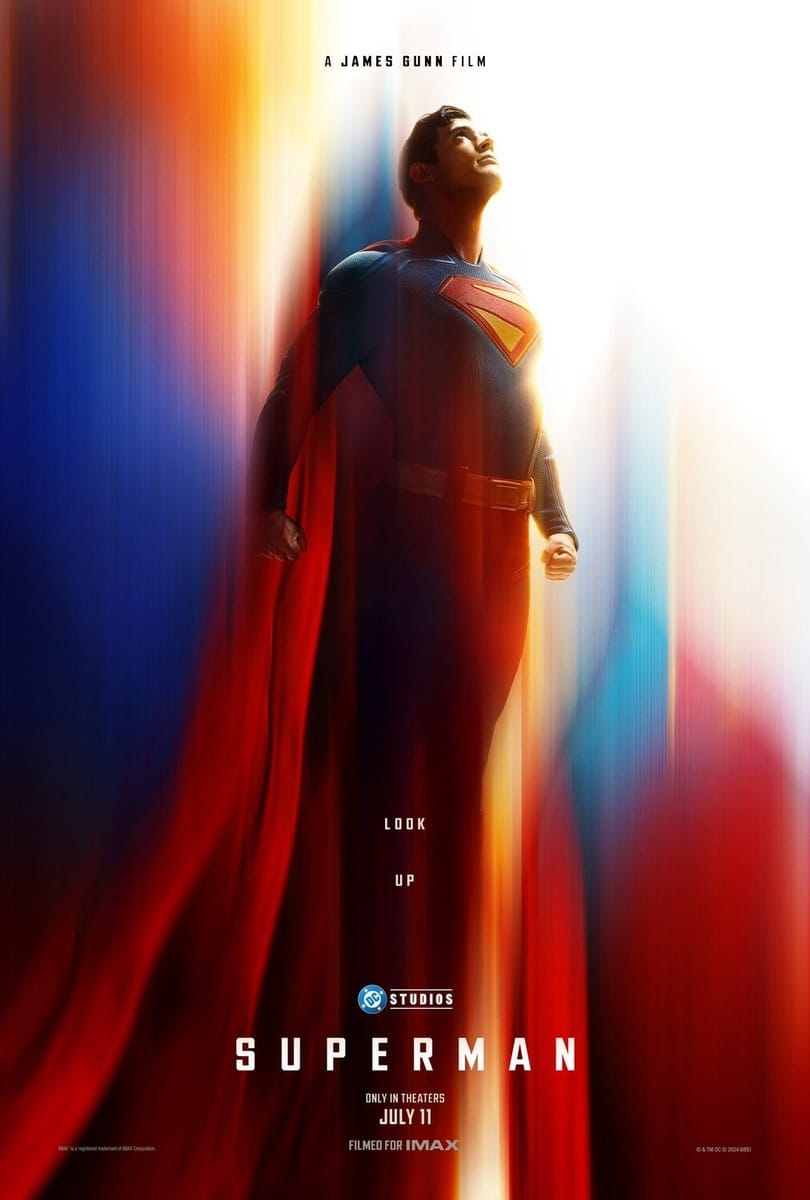
When Superman is drawn into conflicts both at home and abroad, the world questions not just his actions, but his character, giving the ruthless tech billionaire Lex Luthor the opportunity to finally get the Man of Steel out of the way for good. Will the intrepid reporter Lois Lane, and Superman's four-legged companion, Krypto, be able to help him before it's too late?
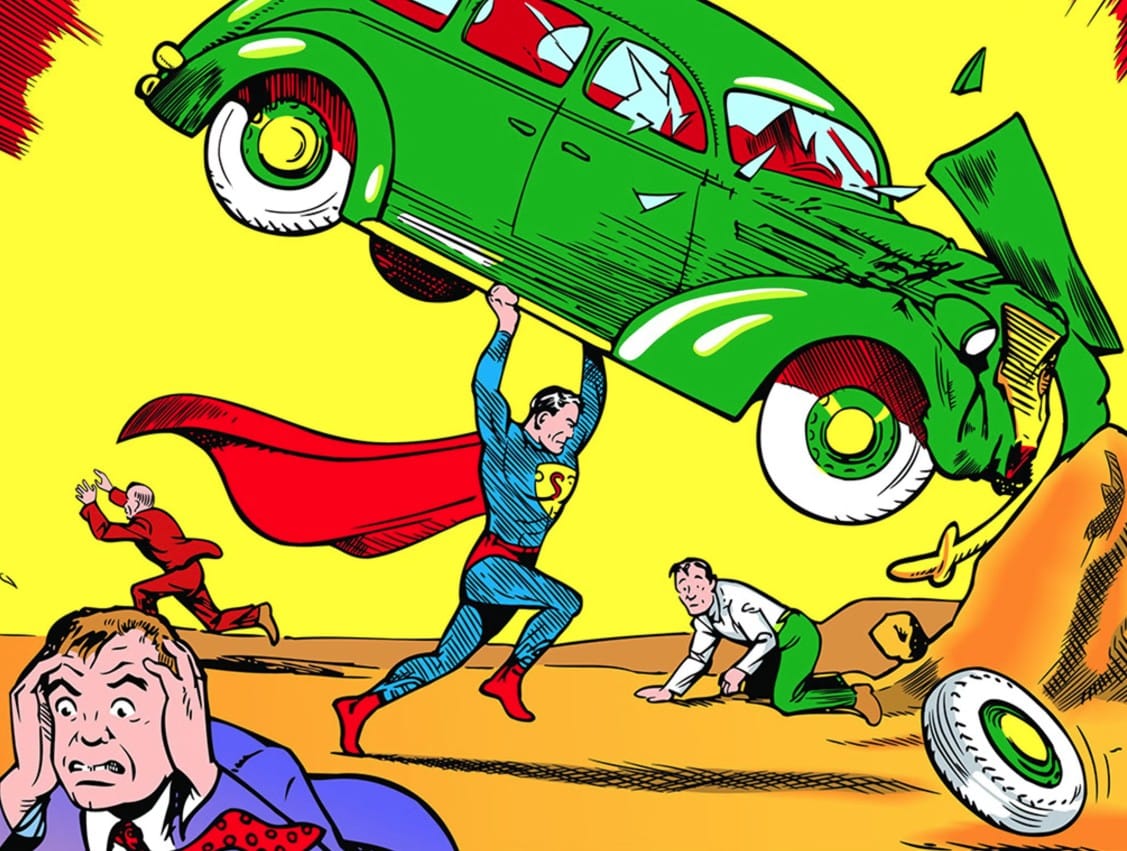
First appearing all the way back in 1938, while Superman may not technically be the first superhero to appear, he's definitely the first modern superhero. But that aside, he is definitely the most famous and the most recognizable superhero of all time. Yes, it's fair to say Batman and Wonder Woman are in close competition, so close in fact, that together they represent the trinity of basic superhero archetypes at their most boiled down–Heaven, Earth, and Magic–but even then, even if they do stand together at that peak, Superman is still at the top. This is because everyone knows who his story.
Most people recognize Wonder Woman, but most of them probably couldn't tell you about her origin. And while Batman is definitely as recognizable as Superman, and everyone knows his origin, the character has been through so many changes, has had so many different versions with wildly divergent focuses, that the fans of the various eras talking about what it is that they like about Batman can often seem like they’re talking about separate characters.
Superman, meanwhile, has never changed.
At least, not in ways that mattered, or in ways that weren’t just gimmicks that didn’t last very long. He’s gotten more powerful, and less powerful over the years too, but in the end, he's always been the same guy from the same place.
Because of that, one thing that I really liked about this film is that it doesn't waste time on retelling the origin story. The film understands that, whether it was from the comic books, the old radio plays, the serials, the Christopher Reeves movies, the crappy Zack Snyder version, the myriad cartoons, the multiple tv shows, or one of the works that was inspired by the character, we already know his story. It’s a completely fictional myth that has been told and retold, much like the story of the first Thanksgiving.
But...
Succinctly, for those of you who aren't so sure about the details, here's how writer Grant Morrison, artist Frank Quitely, and inker/colorist Jamie Grant retold that story in All- Star Superman #1 in November of 2005...
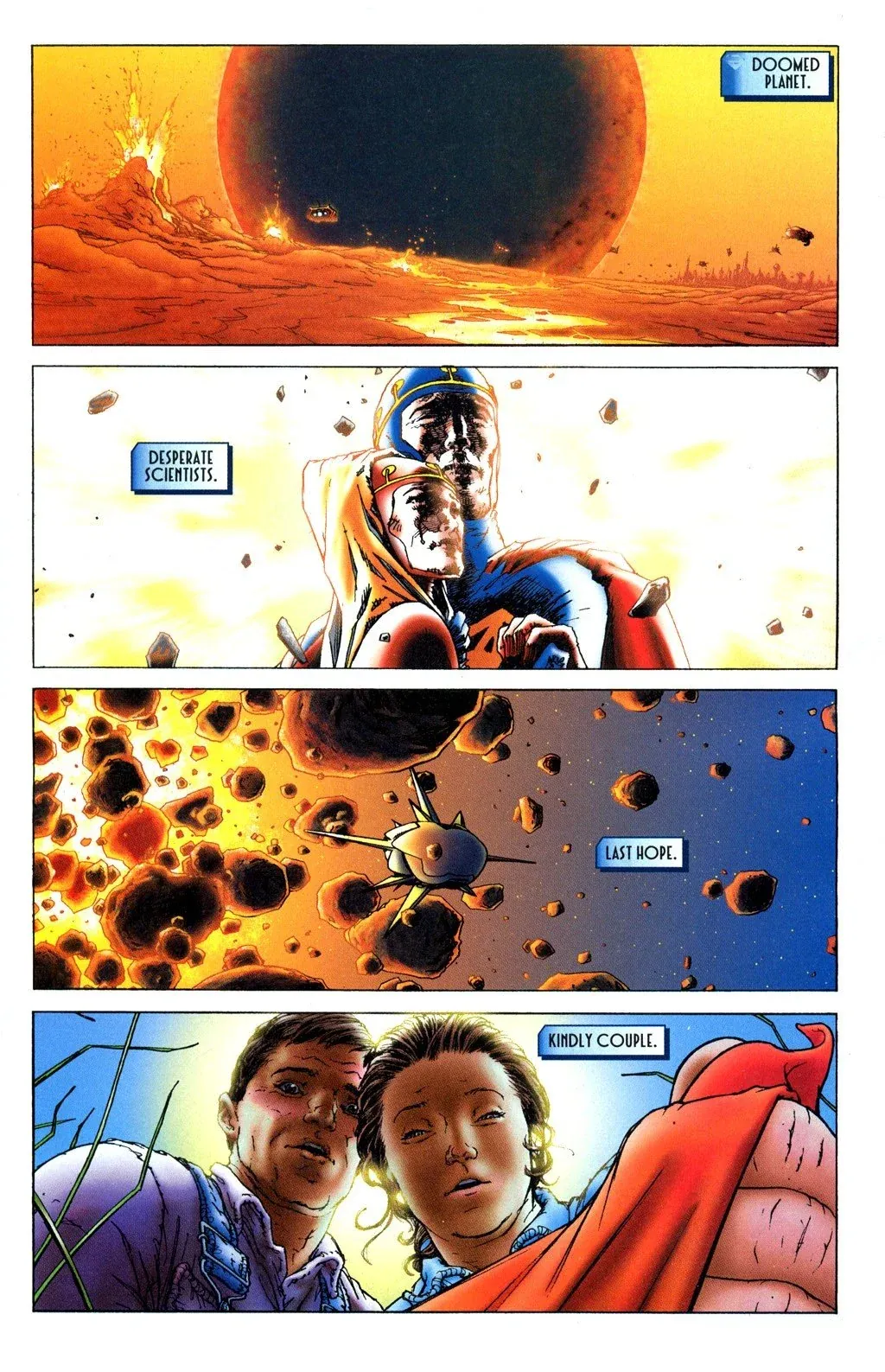
See? You knew that.
And this film is savvy enough to recognize this.
This is because James Gunn is a very savvy storyteller and film director. I’ve long been a fan of him and what he does, from his early Troma stuff, on through Slither and Super and PG Porn, to the screenplay for the 2004 reimagining of Dawn of the Dead, his Scooby-Doo movies too, on to the Guardians of the Galaxy and his MCU work, and now his new era with WB/DC with The Suicide Squad, The Creature Commandos, and Peacemaker. I like his stuff. Between his writing style, his eye for characters, his politics, not to mention his sense of humor and his taste in music, not to mention his obvious familiarity with comic books, especially since it's clear in all of his work what it is that he likes about this stuff in the first place, which seem to me be basically the same reasons that I happen to like that stuff too... simply put, he makes the kind of genre work I enjoy.
And Superman is no different.
I tell you all this as a bit of a head's up, so that you'll know that you're free to take my reaction to this film with a grain of salt, because obviously, I was already in the bag before I even sat down.
I also tell you this because I don't care if you think I was too willing to like this film sight unseen, because it ultimately doesn't matter how I felt going in. The simple fact is, Superman is a good movie. Nothing but a good time at the cinema. It's fun for the whole family, and not in the bad way that saying that usually means either. It's smart. It's funny. It's fun. It's exciting. It's not afraid to be silly. Best of all, it's optimistic, and has a central message of doing what's right simply because it's the right thing to do.
I loved that.
Clearly pulling its inspiration from a cross-section of the best sources, like the Christopher Reeves Superman movies, as well as some of the classic Superman and Justice League comics, this is a film that will not only get you to believe that a man can fly, but that he can also be super at the same time.
It's the perfect film for our current dark times.
The Characters
Superman
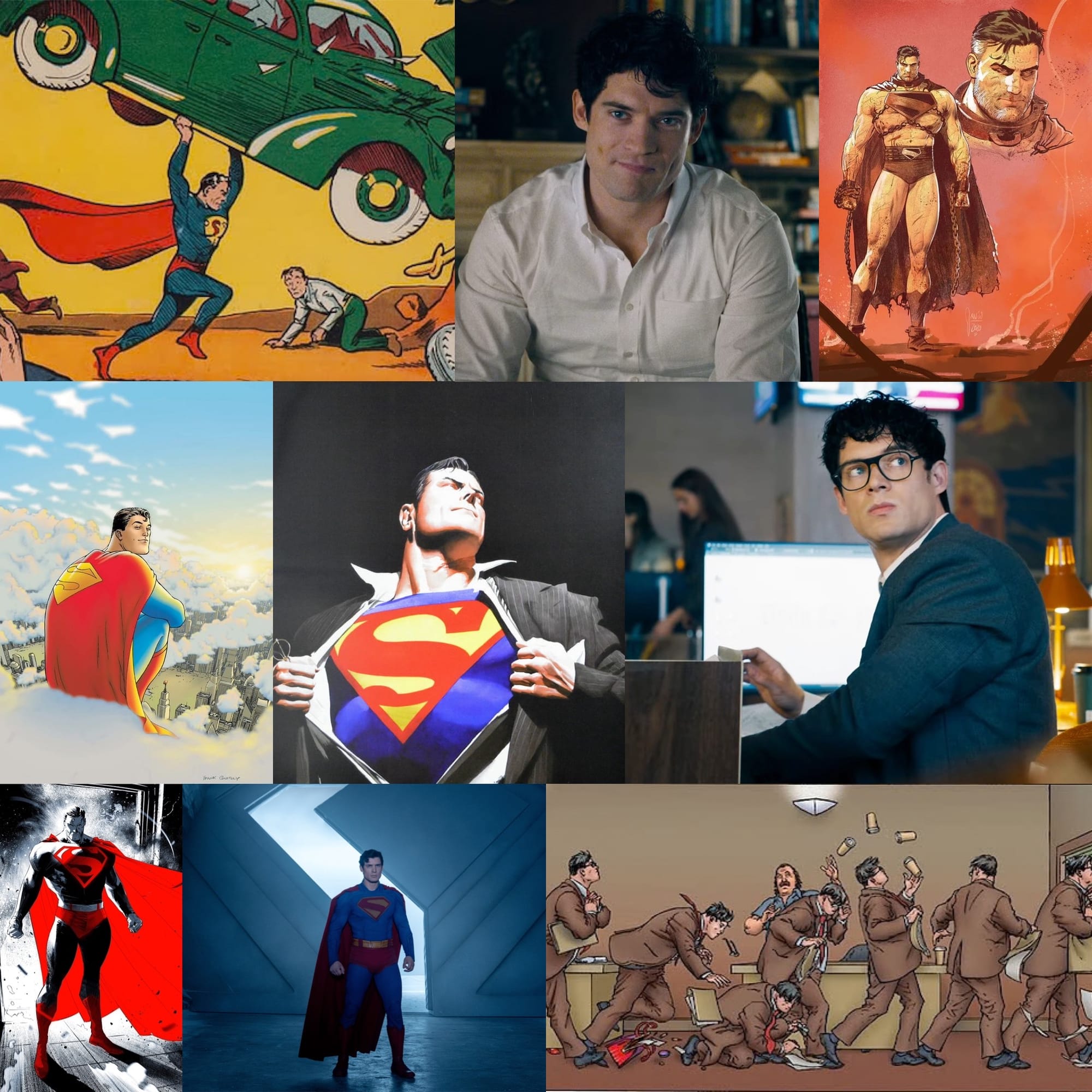
Created by writer Jerry Siegel and artist Joe Schuster, Superman debuted in Action Comics #1 in June 1938. The comic sold for just ten cents 87 years ago, and then last year, was sold by Heritage Auctions for $6 million. That's the most expensive comic ever, but then, it's also the ur-source of modern superheroes, the most important, and most impactful, comic book ever published, responsible for sparking a global industry that has now made billions and billions of dollars.
As part of the deal to publish their creation in Action Comics #1, Siegel and Shuster sold the rights to the character for $130, and a contract to continue to supply the publisher with material. It was a work-for-hire kind of deal and a fairly typical agreement for the time, sure, but still you'd think that with time, there’d an acknowledgement to these two men for the debt they were owed, for the thing they created, and the industry they helped to give birth to. You’d think that such a thing was so obviously deserved even a soulless corporation would see it, and be moved to make sure that happened.
But, nope.
Over the years, WB/DC refused to give Siegel and Schuster their due, fighting them tooth and nail in court at every opportunity in order to prevent any kind of commensurate acknowledgement from happening. As a result, their lives were filled with financial struggles and medical debt until their deaths in the mid-90s.
Siegel and Schuster were both the children of Jewish immigrants, and so their creation’s story reflected that. A refugee and an immigrant who finds kindness, acceptance and a new home as they become in America, this aspect of Superman is often pointed to in particular for the way it taps into something that, until recently, has long been touted as an important piece of the American identity. Sadly, in the end, their creation proved to be false, and it was the lives of Superman’s creators themselves that ended up showing us the true reality of the American Dream.
Lois Lane
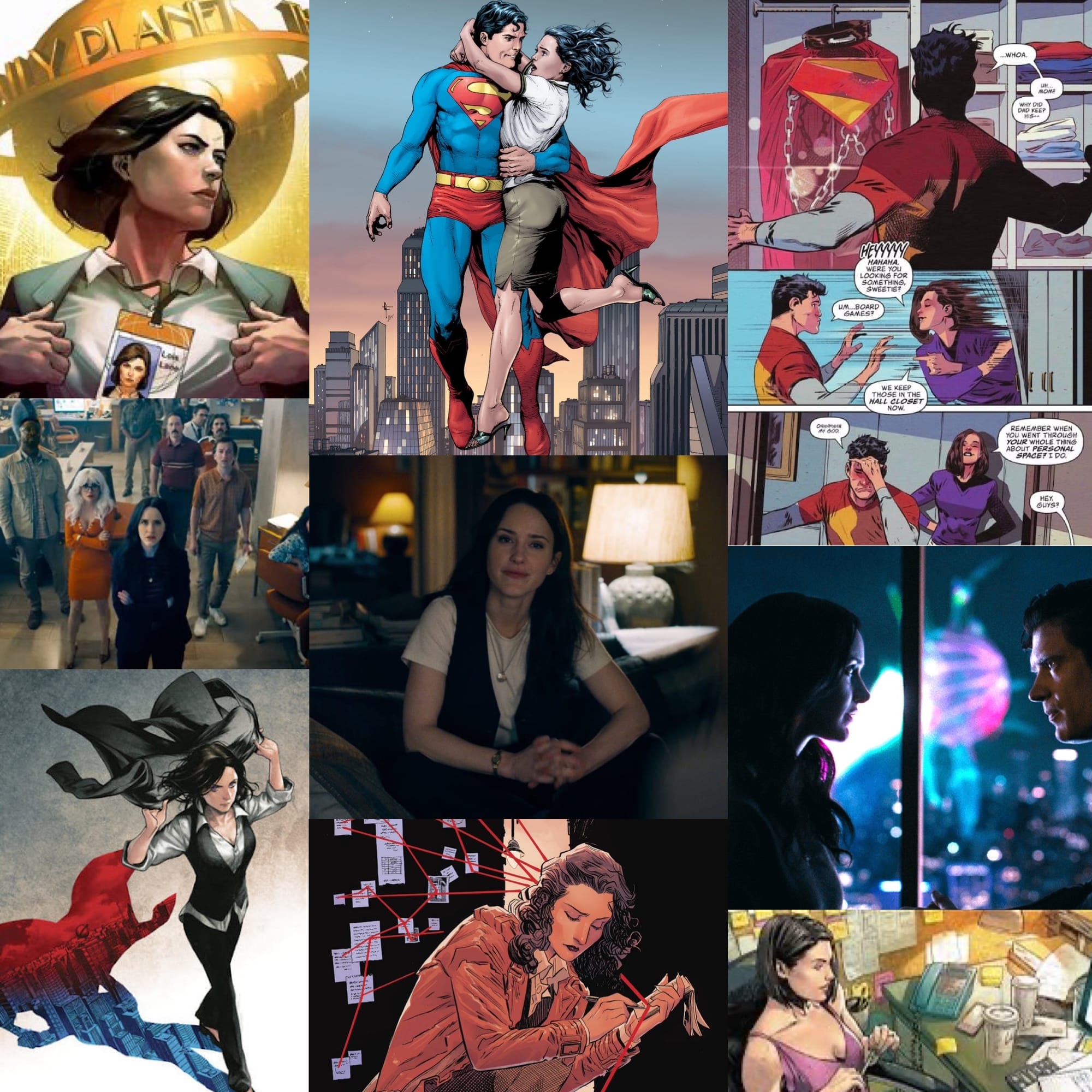
Also created by writer Jerry Siegel and artist Joe Shuster, and also first appearing in Action Comics #1 in June of 1938, Lois Lane is famously a journalist who works for the Metropolis newspaper the Daily Planet. After 58 years of dating, she is also the wife of Superman and his alter ego, Clark Kent. In the continuity of DC comics, she is the mother of their son as well, Jonathan Kent, who is now flying about the DC Universe, and also known as Superman.
While she has always been portrayed as a dauntless journalist, as well as the intellectual equal to Superman, for a long time, she was mostly a ready hostage, a bit of a nosy parker whose curiosity would get her into trouble, which would then provide a reason for Superman to smash through a wall and rescue her. But in the years since, Lois has evolved into a tough and resourceful investigator, one that even Batman respects, and maybe fears a little too.
But she still sticks her nose in to places that she shouldn't, and gets in a lot of trouble as a result, that part at least has never changed...
Jimmy Olsen
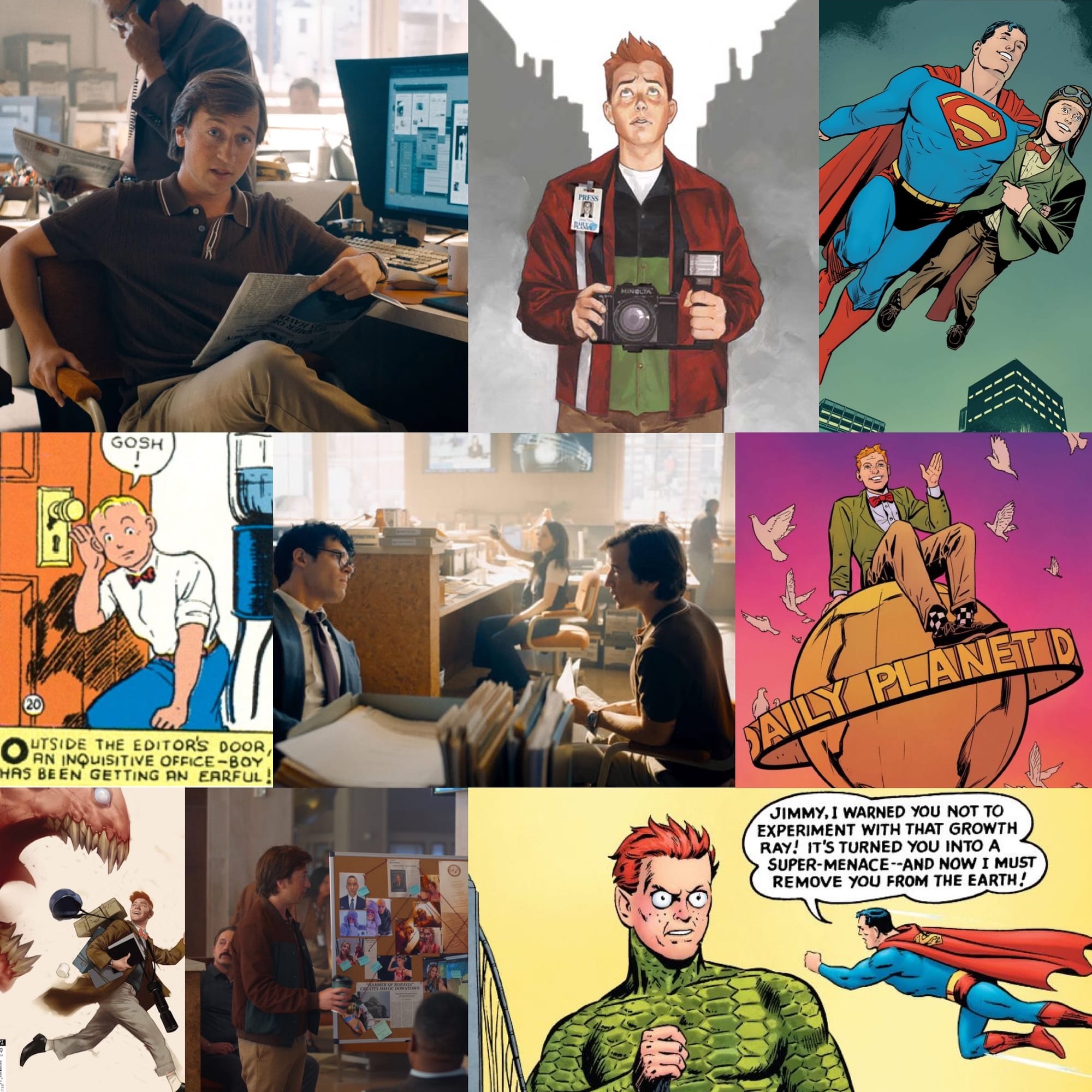
Jimmy Olsen is a young photojournalist working at the Daily Planet. He's Superman's pal. He's the guy who wears a special wristwatch so that when he's in trouble, he can press a button and it will emit a signal that Superman can hear anywhere in the world, so that he’ll know that he needs to come save Jimmy.
Originally appearing as an unnamed "office boy" with a bow tie in Action Comics #6 in November 1938, the character was first officially introduced as Jimmy Olsen on the radio show, The Adventures of Superman, on April 15, 1940, and then, after a few other unnamed appearances in comics, finally appeared as Jimmy Olsen in Superman #13 in December 1941.
The Silver Age of Comics (the late 50s to the early 70s) was really Jimmy Olsen's era. This is when he would often find himself having been temporarily transformed into something strange, or stuck in strange situations, or having to wear a disguise for one reason or another. During this time, he had the power of super-speed, and super intelligence, and super-elasticity, and fire breath, but not at the same time. He's been radioactive. At various times he was turned into a genie, a werewolf, an alien, a viking, a hippie, a giant turtle man, a human porcupine, and a woman. He became morbidly obese once, in order to stop a jewel smuggling ring, and also to impress the circus fat lady. He briefly had the powers of the Mayan Gods. Another time, he grew a giant beard. Once, he became a human octopus after eating some extraterrestrial fruit. And in what was maybe the most American story of all time, one time Jimmy Olsen was turned into a gorilla, but he still had to go to work.
Lex Luthor
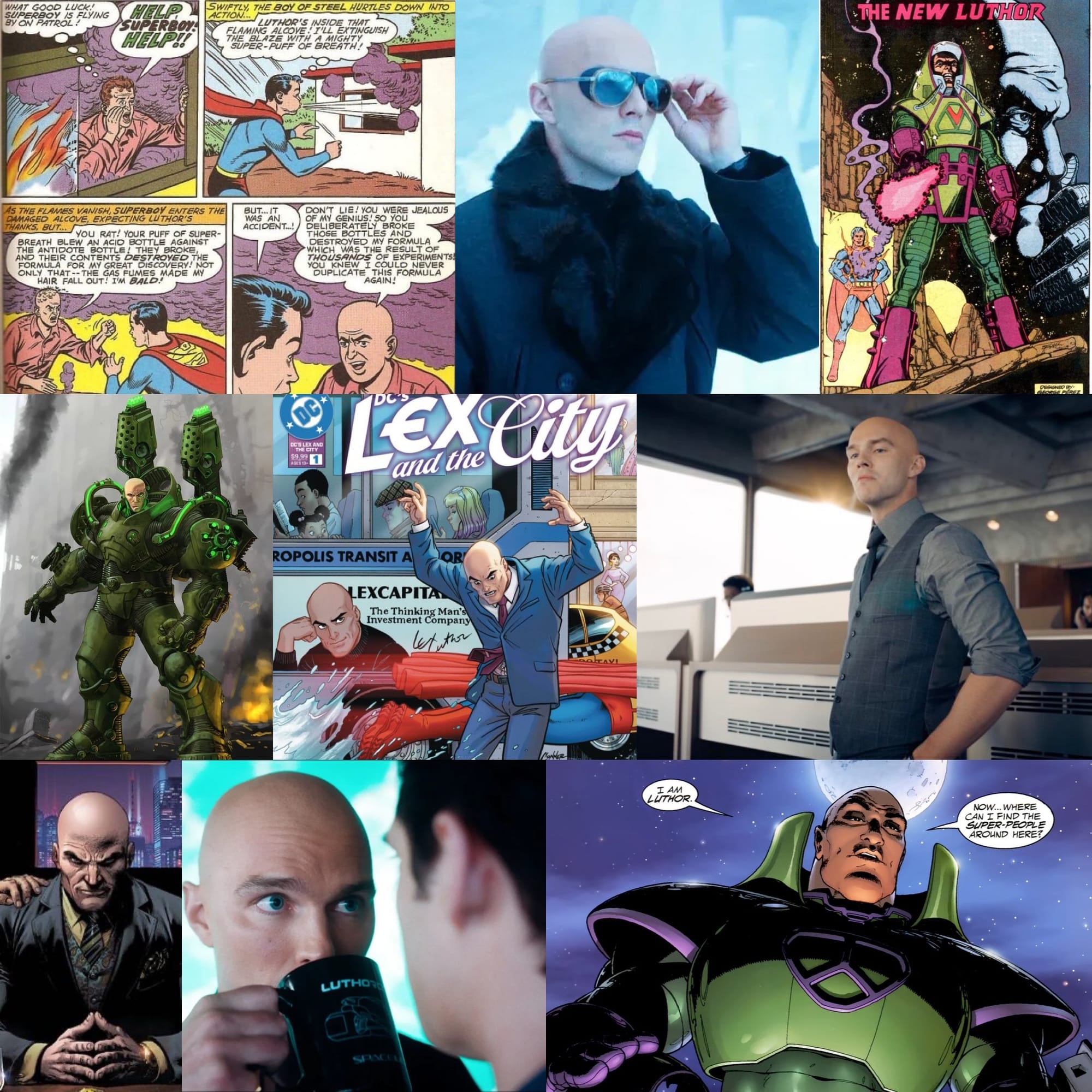
Another creation by writer Jerry Siegel and artist Joe Shuster, Lex Luthor first appeared in Action Comics #23 in April 1940. He is the long-time archenemy of Superman, and other than the Joker, he is maybe the mose famous supervillain of all time. What makes Lex stand out is that unlike many supervillains, Luthor has neither superpowers nor secret identity. He is proud, manipulative, pragmatic, and completely lacking in ethical principles, and is driven primarily by vengence, with an insatiable thirst for control. If he was to be said to have any superpowers at all, it would be that he is insanely rich and an unparalleled genius, both of which he uses in order to wield a vast influence over politics, science, and technology.
Also, sometimes he wears a massive green and purple armored war-suit.
These days, Luthor is usually portrayed as a man who does not envy superheroes for their abilities, but rather the adoration and accolades that they receive, which he believes rightfully belongs to him as the lone person smart and capable enough to lead humanity into a golden era. He sees Superman as a threat to this aim, and seeks to eliminate him not only out of personal rivalry, but also because he believes that the mere existence of an all-powerful being like Superman fosters dependence in humanity, and thus, prevents us from achieving our full potential.
But back in the day, teenage Lex Luthor was a huge Superboy fanboy, and also determined to prove he was Earth's greatest scientist. But his recklessness caused an explosion in his lab. The Boy of Steel shows up to save him, but unfortunately, while putting out the fire with his super-breath, Superboy not only destroyed Lex's work, he also blew off all of Lex's hair, rendering him bald.
Lex Luthor has hated Superman ever since.
Eve Teschmacher
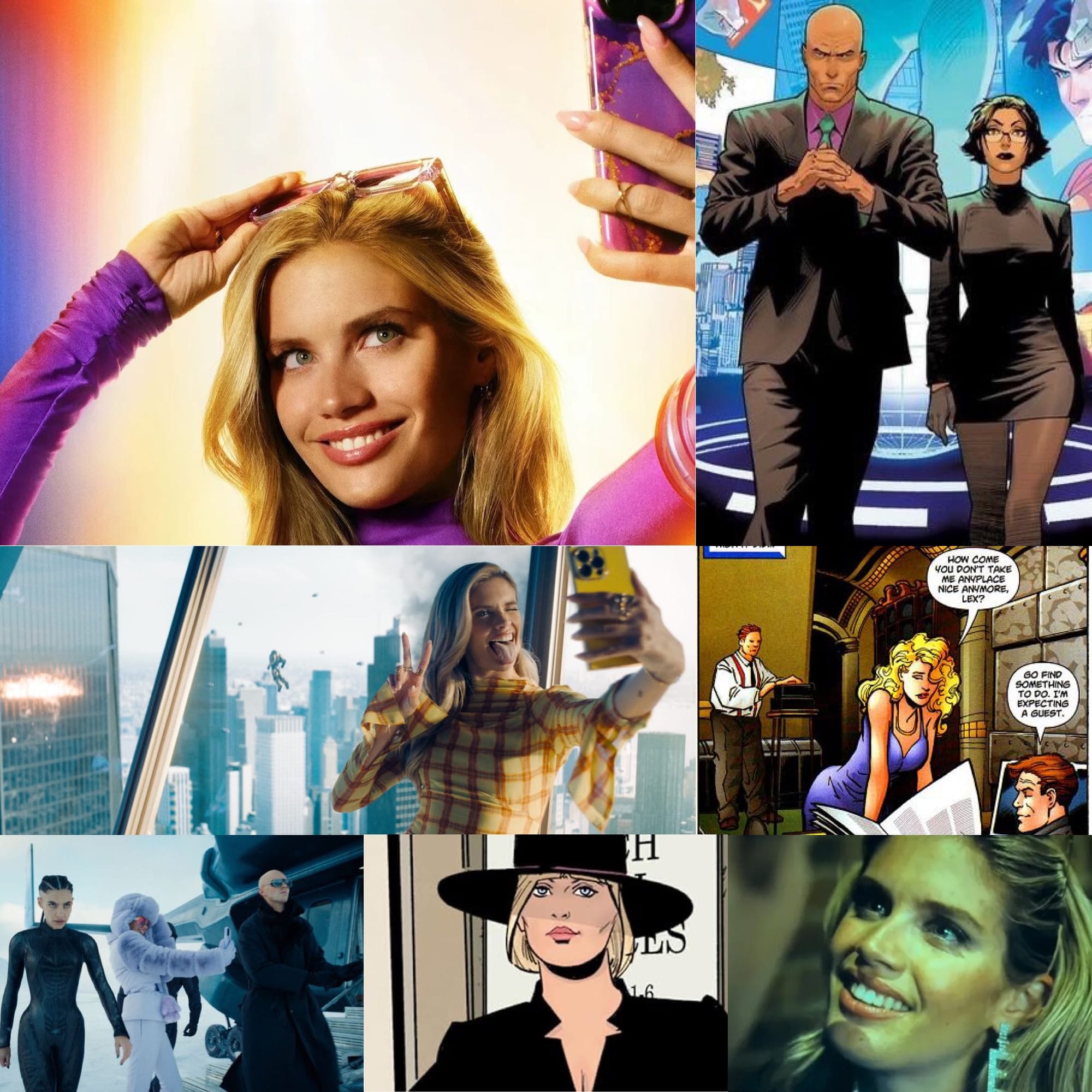
Eve Teschmacher first appeared in the 1978 version of the Superman movie as Lex Luthor's girlfriend, and has subsequently appeared in various Superman tv shows and comic books in the same capacity. While not as much of a traditional gum-chewing and loud Long Island accent-having gun moll like Harley Quinn, for example, that's still basically the role she's always played. Doting. Ditzy. And often asking her "Lexy" dumb questions, or lamenting how he's not taking her out on the town like he used, or that they're yet not married.
Most notably, she is often shown to eventually become reluctant to allow Lex Luthor's more villainous schemes to happen, and her conscience will often move her to betray Lex at the 11th hour.
Krypto
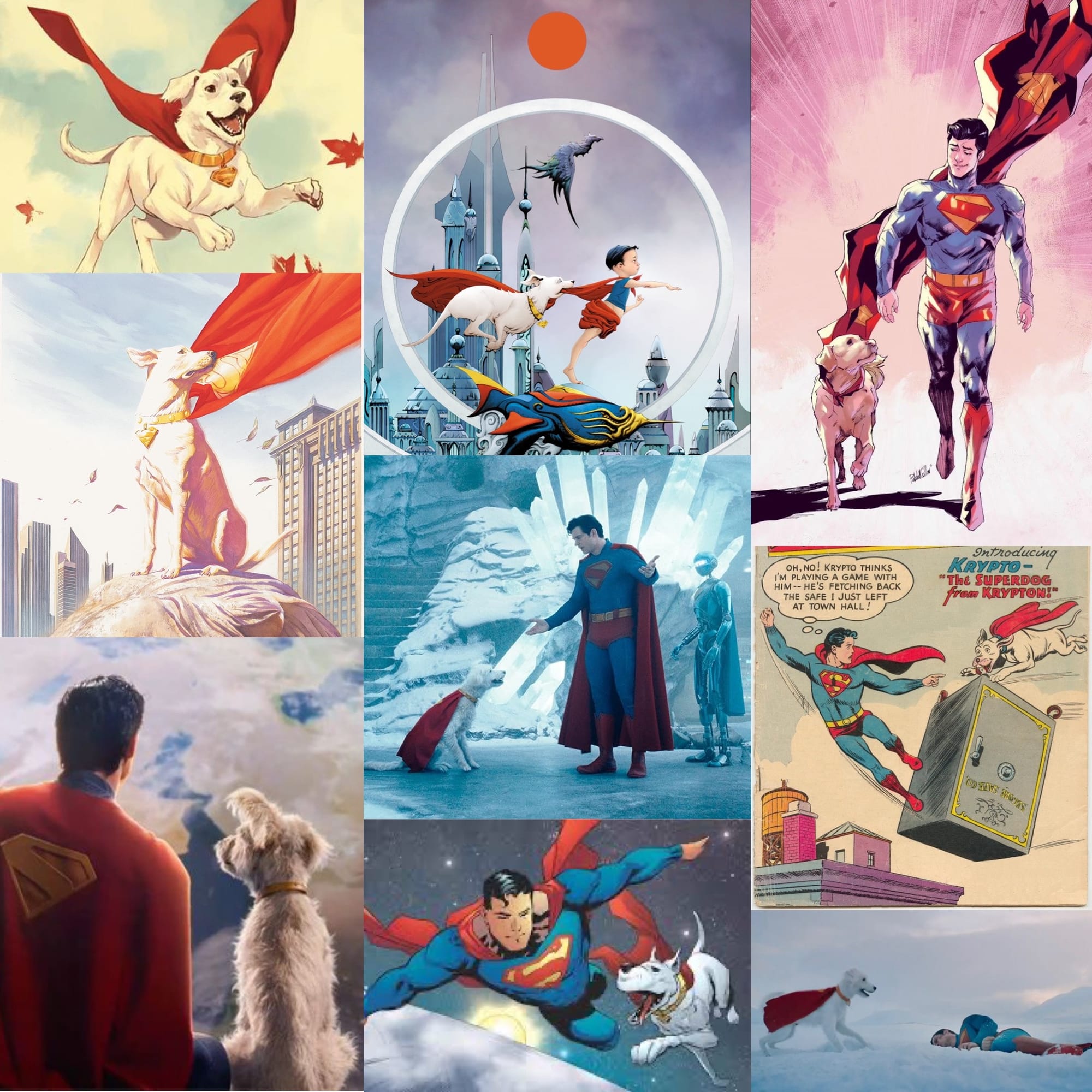
First appearing in a Superboy story in Adventure Comics #210 in March 1955), Krypto was created by writer Otto Binder and artists Curt Swan and Sy Barry. He is the last dog of Krypton, and he is a good boy. Or at least, he tries to be. He's a dog, so he gets excited and jumpy pretty easily. A lot. He chews on stuff. He digs. He's not very good at sitting. He tries to be a good boy. Sometimes. Mostly.
Krypto is also loyal and fierce, and a stalwart companion who won't hesitate to defend his friends. He usually wears a cape, because apparently Kryptonians are just like hippies who force their dogs to wear bandanas, and he has similar powers as Superman, as his Kryptonian biological nature is enhanced by Earth’s yellow sun.
I shudder to imagine what his poops are like.
Ultraman
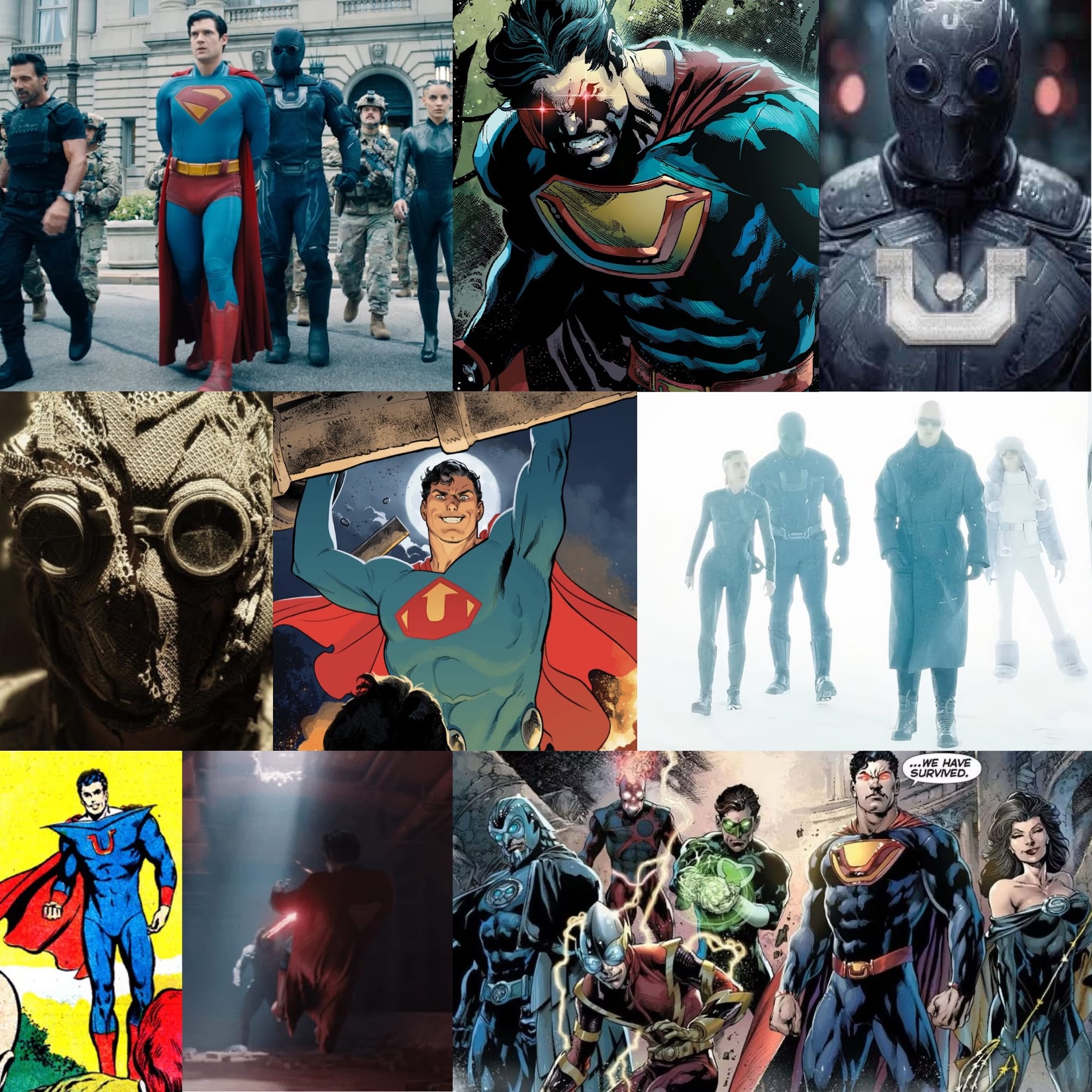
The Multiverse in DC Comics is either infinite or finite, depending on which creators are running the current main continuity, but either way, much like the alternate universe in Star Trek where Spock has a goatee, the alternate dimension where the planet known as Earth 3 resides is DC's evil universe. And Ultraman is basically evil Superman. He possesses the same superpowers as Superman, but he is sometimes portrayed as being weakened by yellow sunlight and empowered by kryptonite. With these kinds of "opposite" details about the character, it should be noted that Ultraman is not to be confused with Bizarro, who is the actual opposite version of Superman.
Created by writer Gardner Fox and artist Mike Sekowsky, Ultraman first appeared in Justice League of America #29 in August 1964. Cruel, stupid, greedy, and often portrayed as a puffed-up tough guy Jersey Shore type goon, Ultraman is the leader of the Crime Syndicate, the Earth 3 evil version of the Justice League. In a nutshell, he's basically the type of character who is not only powerful enough for Superman to be able to punch without having to restrain himself, he’s also someone who 100% deserves the ass-kicking.
The movie version is a little different than the comic version, playing off an idea from Superman IV: The Quest for Peace, but it works out the same in the end.
The Engineer

Created by writer Warren Ellis and artist Tom Raney, and first appearing in Stormwatch #48 in 1997, Angela Spica, otherwise known as The Engineer, is a scientist who replaced her blood with nanotech, and as a result, can cover her body in an armored skin from which she can create all sorts of solid objects, but mostly engines, blades, and guns.
I'm not a big fan of the Engineer's design in the movie. It's kind of boring. To be fair, I wasn't a huge fan of the slick silver look of the original either, but I did like the more mech look of the Wild Storm version. At the very least, I definitely would have preferred silver to black. Especially with Ultraman already wearing black, but whatever, that's not a deal breaker for me.
Plus, I'm curious about her future, as in the comics, The Engineer was part of the superteam known as the Authority, which is the focus of a supposedly upcoming film from WB/DC, and in this film, she's definitely more of a bad guy henchman, so I'm curious what they do with her character in the future.
We shall see...
Guy Gardner
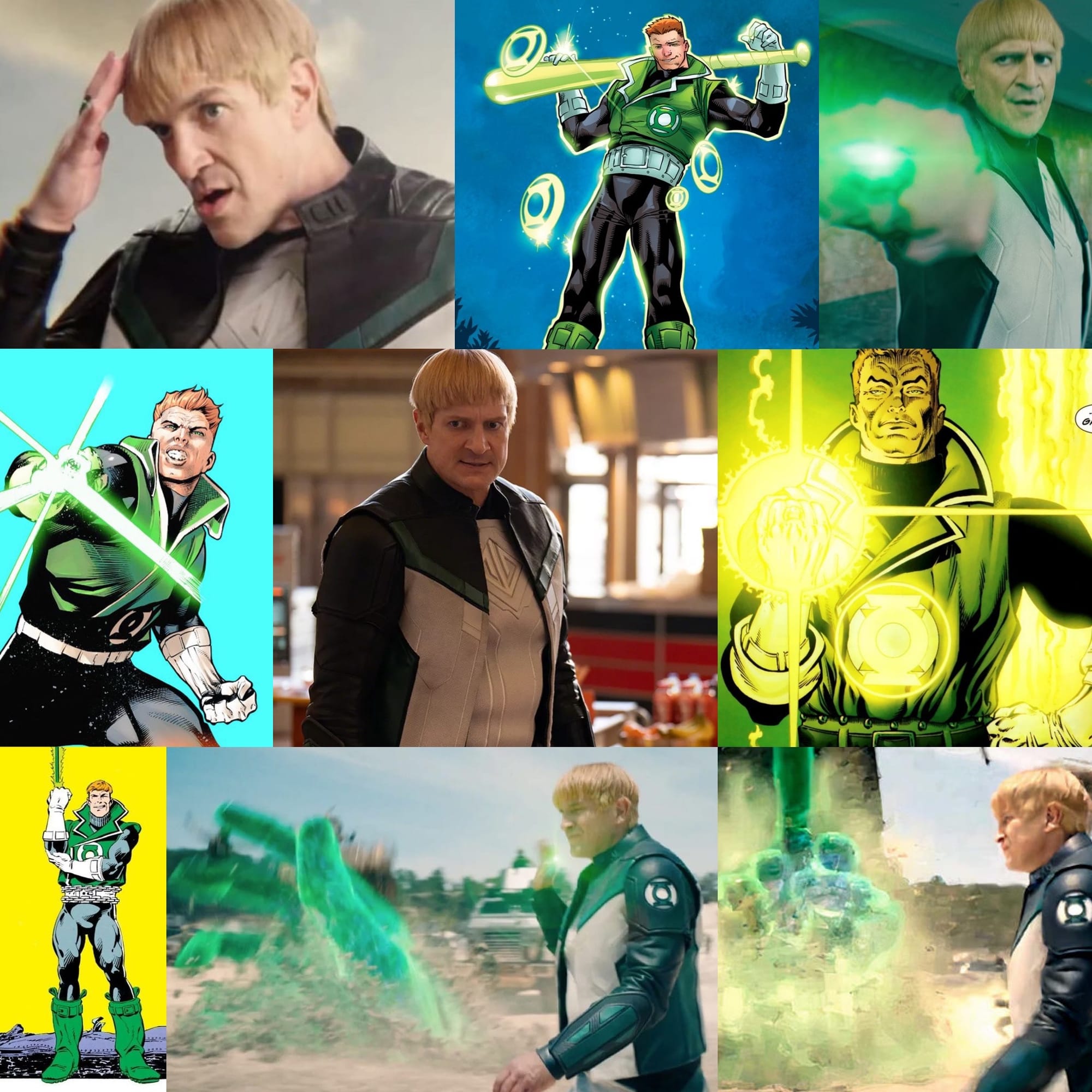
Originally created by John Broome and Gil Kane in Green Lantern (vol. 2) #59 in March of 1968, Guy Gardner is one of the many Green Lanterns from Earth.
Green Lantern is the name used by several superheroes, most of whom are part of the Green Lantern Corps—a kind of intergalactic law enforcement agency made up of sentient beings from all across the galaxy—and all of whom fight evil with their semi-sentient green-colored rings, that are powered by willpower. Through the rings, they are given a variety of abilities, flight, environmental adaptibility, and most often, the ability to create anything they can imagine out of green energy. The rings used to require recharging every day, and also had a "vulnerability to yellow" which was... weird… but now, much like Ash's trusty shotgun, they only need to be reloaded dramatically. To do this, the Latern need only to hold the ring up to its green lantern-shaped power battery and recite the Green Lantern code:
"In brightest day, in darkest night, no evil shall escape my sight, let those who worship evil's might, beware my power... Green Lantern's light!"
The first Green Lantern character, Alan Scott, was created in 1940 by Martin Nodell, who fought crime in Capitol City with the aid of his magic ring, despite its "weakness against wood" which was... also weird. Then, in 1959, at the dawn of the Silver Age of Comic Books, John Broome and Gil Kane reinvented Green Lantern as Hal Jordan, introducing the Green Lantern Corps at the same time, and shifting the entire nature of the character and his story from fantasy to sci-fi. Since then, other Lanterns from Earth have emerged, like John Stewart, who was one of DC's first Black superheroes, and others, like Kyle Rayner, Simon Baz, Jessica Cruz, Keli Quintela, and Jo Mullein too.
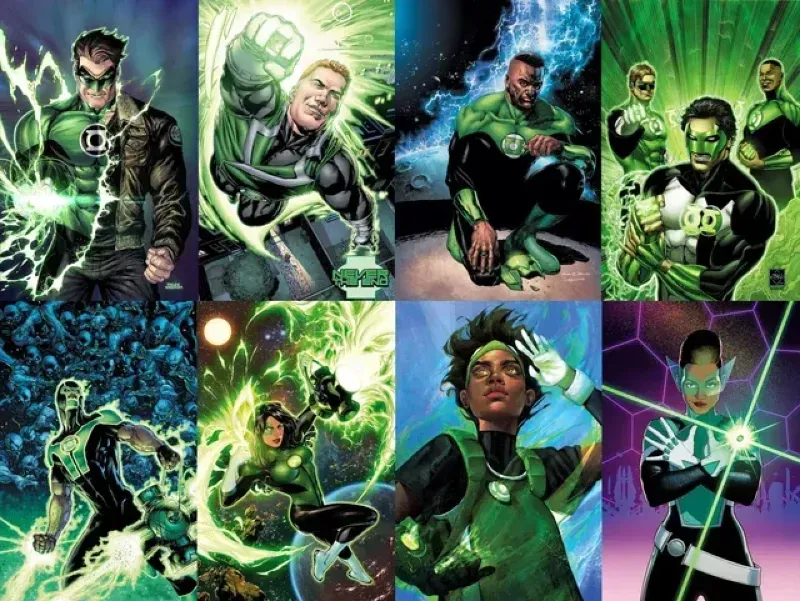
Guy Gardner is one of them. In the 1980s, his character was changed by Steve Englehart and Joe Staton, turning him into a jingoistic parody of an ultra-macho red-blooded American male, a choice that has proven to be popular, and has been the character's personality ever since. Because of this, there was a time in the 90s where Guy Gardner was kicked out of the Lanterns for being a dick, so he started using a yellow ring, wore a leather jacket, and also tucked his jeans into his cowboy boots, because he was the bad boy of superheroes. I'm looking forward to Nathan Fillion rocking that outfit at some point.
And yes, Guy has always had a bowl cut. They try to give him more of a regular person haircut every once in a while, but the bowl always returns eventually. The bowl is eternal.
Hawkgirl
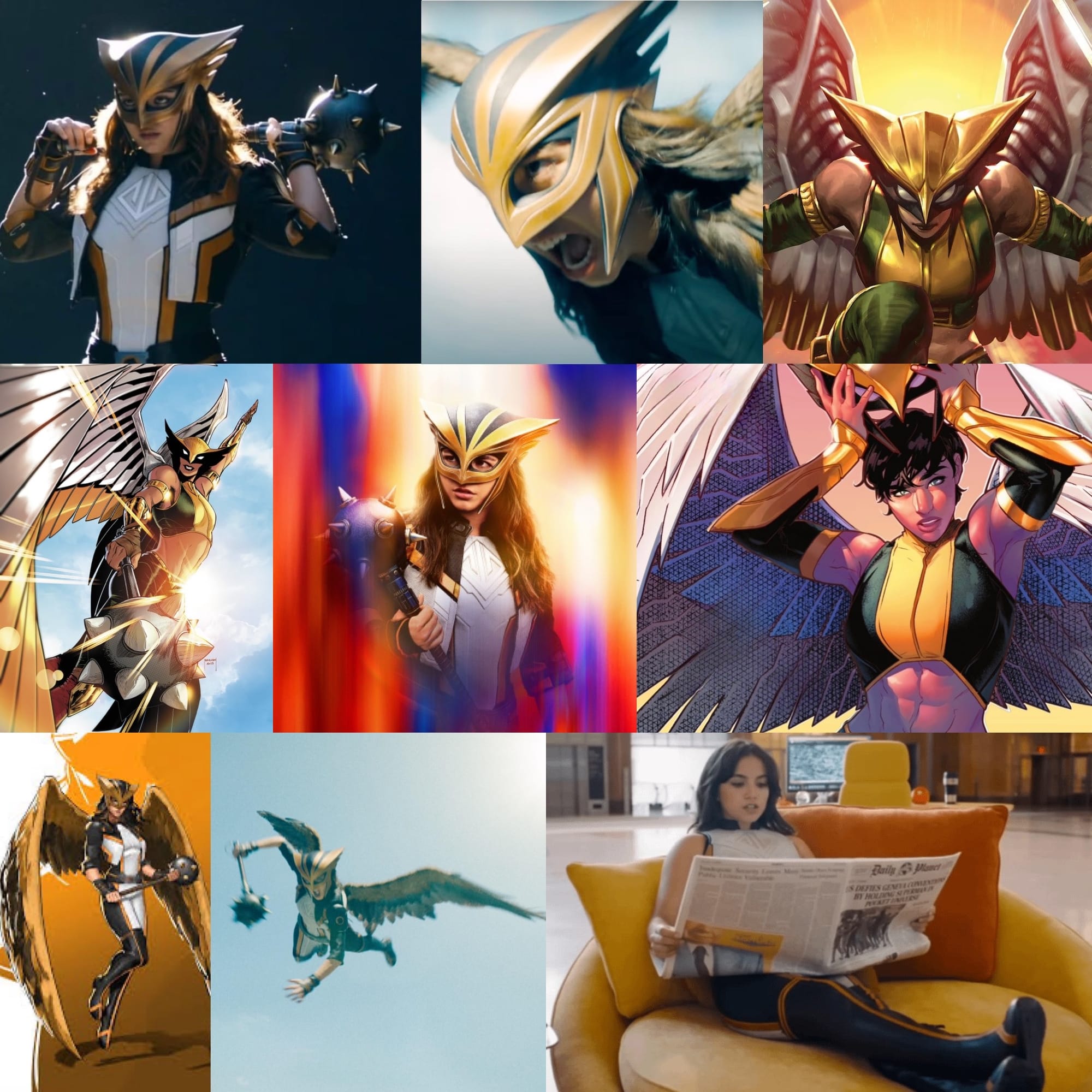
There's been multiple Hawkgirls, but that's kind of the character's thing. The original Hawkgirl, Shiera Sanders Hall, was created by writer Gardner Fox and artist Dennis Neville, and first appeared in Flash Comics #1 in January 1940. The second Hawkgirl, Shayera Hol, was created by writer Gardner Fox and artist Joe Kubert, and first appeared in The Brave and the Bold #34 in March 1961. The third Hawkgirl, Kendra Saunders, was created by writer David Goyer and artist Stephen Sadowski, and first appeared in JSA: Secret Files and Origins #1 in August 1999.
Much like Hawkman, each Hawkgirl has a muddled and confused history of sometimes being a winged warrior alien from the planet Thanagar, and sometimes being the reincarnated female half of two lovers from ancient Egypt who have lived and died and been reborn over and over in constant cycle of love, war, and death, and sometimes being a little from column A and a little from Column B. All these versions have been separate characters, then merged into one, and then separated again over the years. In short, like Hawkman, Hawkgirl is a narrative mess.
But she carries a big honkin' mace though, so that's cool.
Mr. Terrific
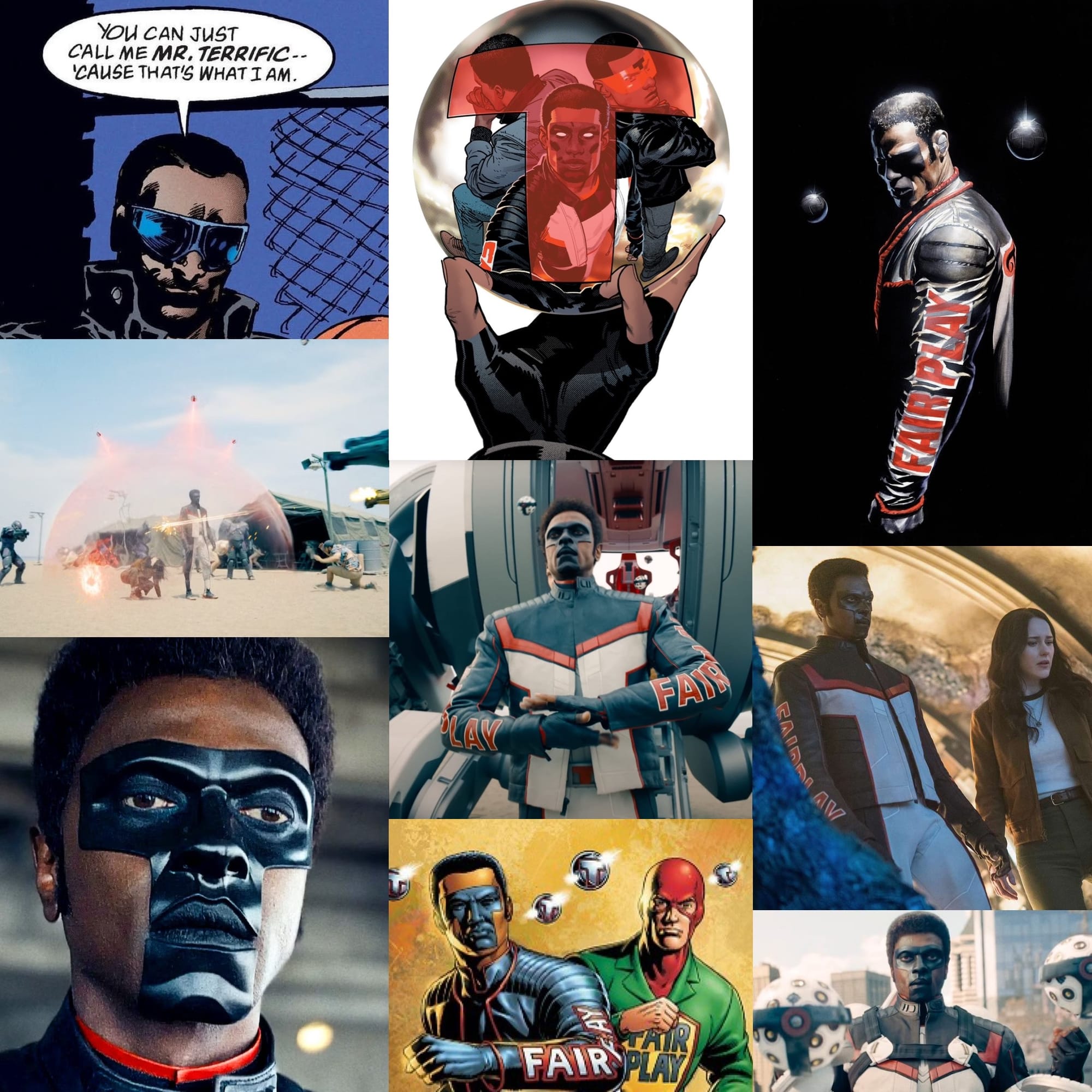
Michael Holt, AKA Mr. Terrific, first appeared in Spectre (vol. 3) #54 in June of 1997, created by John Ostrander and Tom Mandrake. Much like the Green Lantern and Hawkgirl, amongst others, Mr. Terrific is a revamp of the original Golden Age version of Mr. Terrific, Terry Sloane, who was created by Charles Reizenstein and Everett E. Hibbard, and first appeared in Sensation Comics #1 in January 1942.
Much like Terry Sloan, who was a genius Olympic-level athlete who suffered from depression and turned to superheroing and a focus on "fair play" to turn his frown upside down, Micheal Holt is commonly depicted as a genius and athlete who also suffered from depression. But then, on the verge of suicide, he stumbled upon the story of Terry Sloane. Inspired, Michael adopted the "Mister Terrific" identity, as well as the hero's concept of "Fair Play" and became a superhero. Now, as Mister Terrific, he uses his intelligence and wealth and martial arts skill to defend Earth.
He also has these floating balls that he uses as weapons and information-gathering devices called T-Spheres, and they're pretty awesome.
Metamorpho
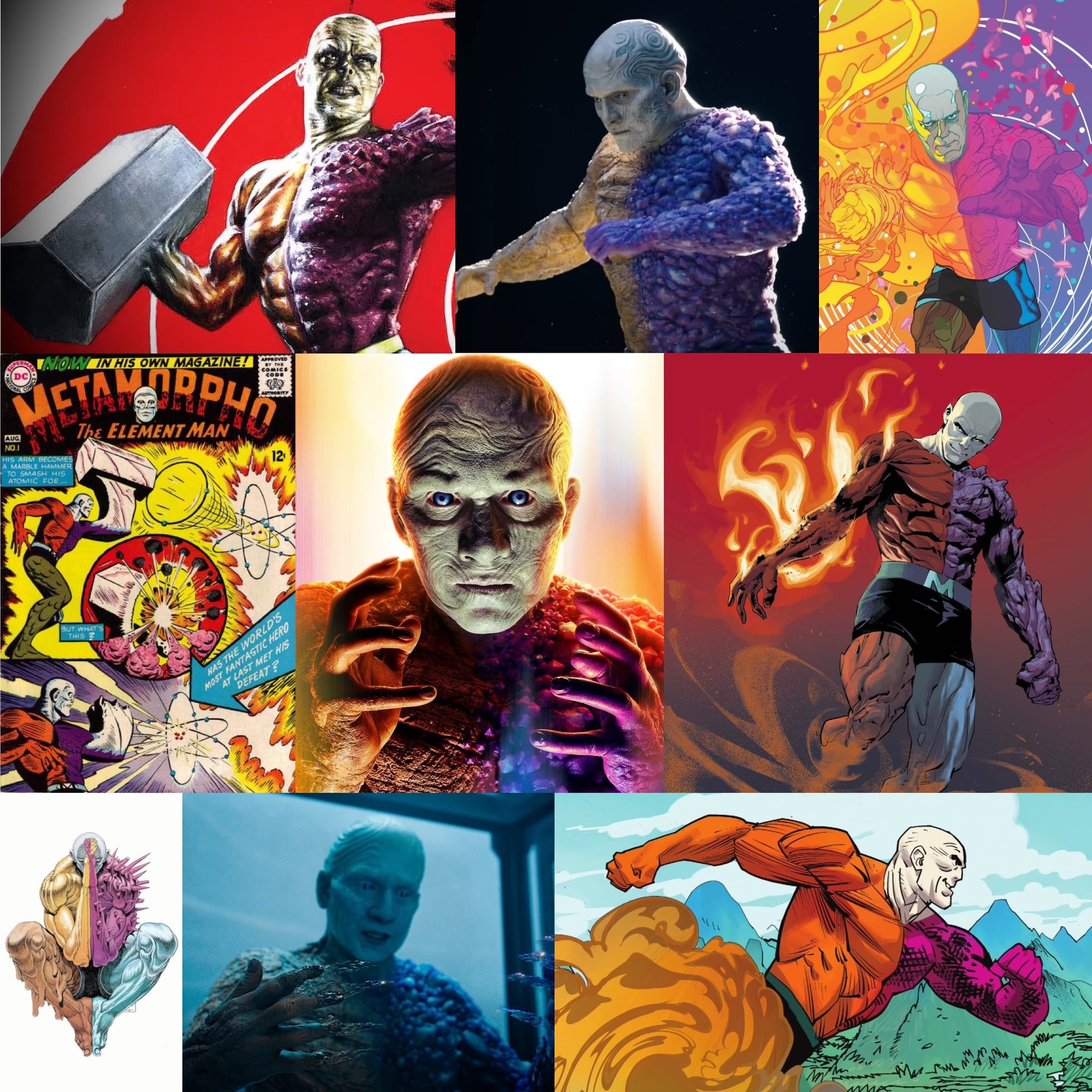
Created by Bob Haney and Ramona Fradon, and first appearing in The Brave and the Bold #57 in January 1965, Rex Mason was an cocky adventurer and a soldier of fortune who was hired by Stagg Enterprises CEO Simon Stagg to steal an Egyptian artifact, the Orb of Ra. Unfortunately, shortly after hiring him, Simon Stagg learns that Mason has been secretly schtupping his daughter, Sapphire Stagg. This upsets Simon, so he tries to kill Rex by knocking him unconscious and then exposing him to the radioactive meteorite from which the Orb of Ra was fashioned.
But this did not kill Rex Mason, no... It transformed him! Into Metamorpho, the Element Man! Rex was now a metahuman made up of several different elemental substances, and was now able to chang his shape and chemical composition at will, but unfortunately, he was also cursed with four differently colored and textured limbs and also a weirdly white face.
Faced with this new reality, Metamorpho decided to be a hero, and also to never wear pants or a shirt ever again... opting to wear either gym shorts, or sometimes a speedo, if he's feeling sexy. And probably flip-flops too, I assume. Rex seems like a flip-flop guy. I mean, fuck it, who's he trying to impress, right? Obviously he's also going to wear a belt with the first letter of his superhero name too, but that's not to impress other people, that's just for him.
Also, those shorts could just be his skin. You know that, right? He could've made his shorts out of his own body, and is actually walking around completely naked the whole time, his penis tucked away behind a big flap of skin.
Supergirl
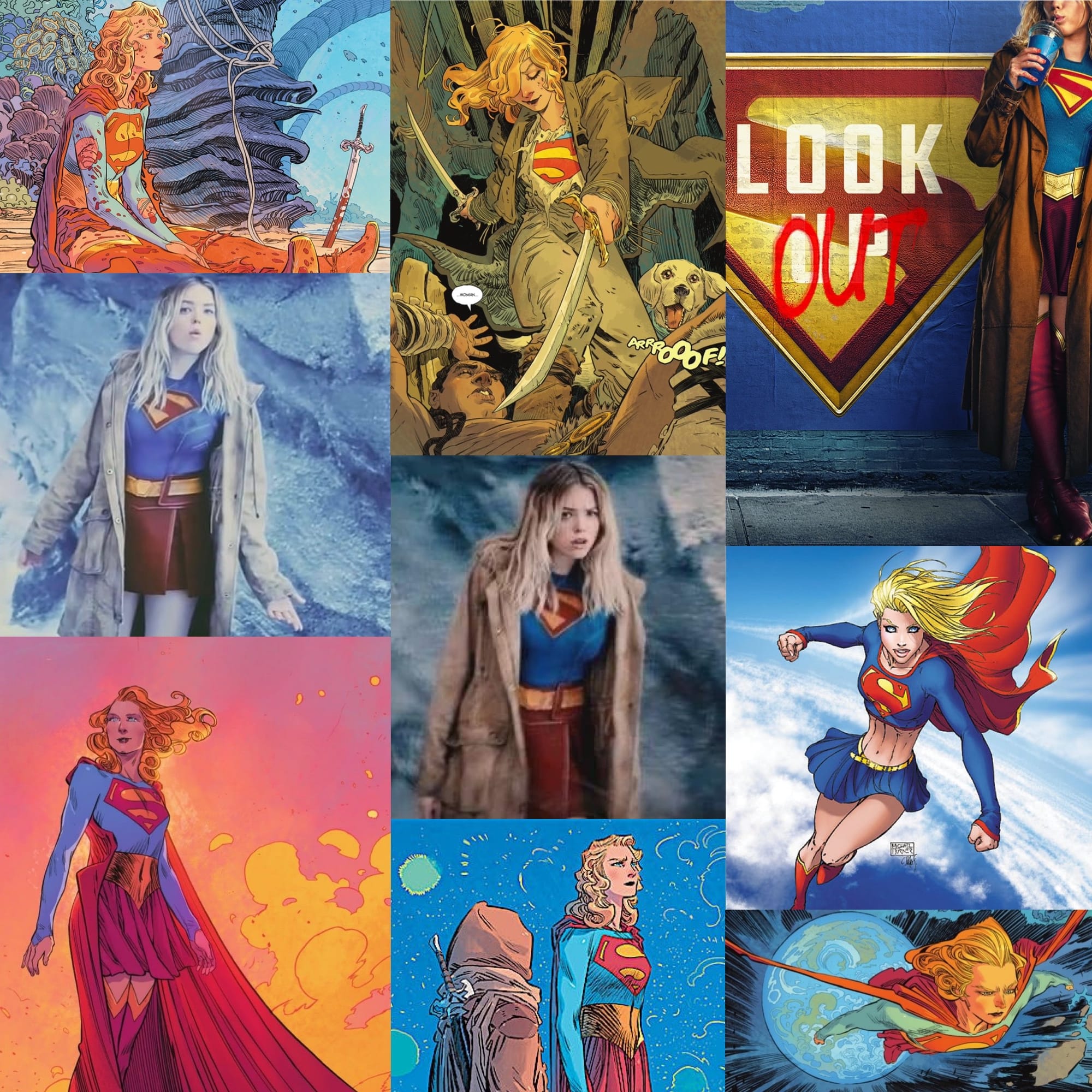
Finally, there's Supergirl.
Created by Otto Binder and Al Plastino, and first appearing in Action Comics #252 in May 1959, like a lot of these characters, there have been multiple versions of this character.
The first Supergirl was Kara Zor-El, the biological cousin of Kal-El, who went on to copy his superhero identity. But then, during the 80s, as DC was desperately trying to straighten its ridiculous tangled continuity into one thread, an effort that would ultimately fail again and again and again, the Superman editors decided that Kara Zor-El's history was too convoluted, so they killed her off during the famous 1985 storyline, Crisis on Infinite Earths, and then they completely wiped her out of existence like she never existed.
Linda Danvers was the next Supergirl. Created by writer Peter David and artist Gary Frank, and first appearing in Supergirl (vol. 4) #1 in September 1996, Linda belonged to a cult, and was meant to be sacrificed, but was saved by a shape-shifting alien, who then bonded with her, giving her superpowers, and so the two decided to fight crime, as you do. Then later, she became an "earthbound Angel" because why not follow tradition and make her ridiculously convoluted? After that, there was a bunch of Angel bullshit and also some Hell bullshit, and I'm not sure if Linda is currently considered alive or not, but really… who cares?
Then there was the big relaunch, the modern version, as Superman's cousin Kara Zor-El returned to the main continuity in Superman/Batman #8 in 2004, by writer Jeph Loeb and artist Ian Churchill. She stuck, and has proven popular, but there have been three or four different reshuffling of reality at DC comics, and Kara has been reborn in each one of them as the same character, but slightly different, and that has continued on to this day. Each relaunch of her title finds itself headed by the same character, but with slight changes. Basically, Supergirl is unkillable. WB/DC keeps trying to cancel her, and she keeps coming back.
But...
The version that shows up in this movie is going to be featured in her own film next year, and it is based off the comic book series called Supergirl: Woman of Tomorrow. It was an eight-issue miniseries by writer Tom King and artist Bilquis Evely from late 2021. It focused on a newly 21 year old Kara Zor-El, and a quest that she undertakes in space with Krypto. It is told from the perspective of a new character named Ruthye Marye Knoll, an alien girl that Kara meets while on a trip across the cosmos, and together, the duo go looking for bloody justice for the death of Ruthye's father at the hands of a criminal named Krem of the Yellow Hills. It's basically a Supergirl story that is set in a Guardians of the Galaxy-styled version of outer space, while telling a loose adaptation of True Grit.
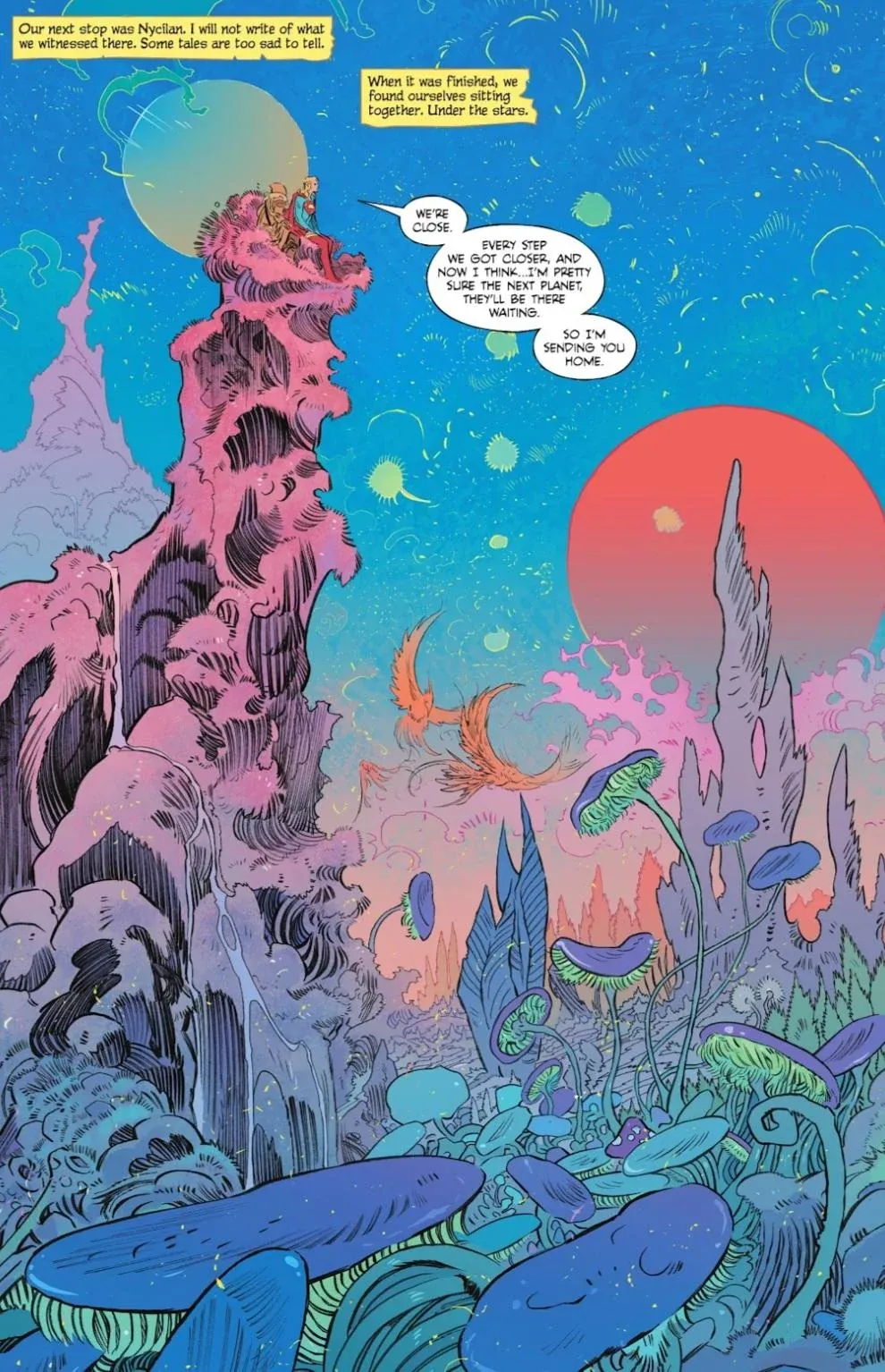
In this story, this version of Kara is vaguely connected with the previous versions in a nice "don't worry about it" kind of way. Her story is familiar. She was born on Krypton before Superman, and when the planet was on the verge of destruction, she was a teenager, while Kal-El was a baby. Kara's parents also sent her away in a rocket. It launched at the same time as Kal-El. They were both heading to the same place, and once they got there, she was supposed to look after him. Unfortunately, her rocket was caught in the shockwaves of the explosion of Krypton, and her ship was knocked far off course. By the time she arrived on Earth, it was years after Kal-El, and he was already grown, already known as Superman, and now, instead of being his big sister, Superman is her big brother.
Yes, that's a big cast for a two hour and ten minute movie, but it works...
The Movie

The film begins with the following text over a field of bright white, undisturbed Artic snow that stretches on to the horizon...
3 CENTURIES AGO, the first superpowered beings, known as METAHUMANS, appeared on Earth, ushering in a new era of GODS AND MONSTERS.
3 DECADES AGO, an extraterrestrial baby was sent in a spacecraft to Earth, and adopted by Kansas farmers.
3 YEARS AGO, the baby, now grown, announced himself as SUPERMAN, the most powerful metahuman of all.
3 WEEKS AGO, Superman stopped the country of BORAVIA from invading JARHANPUR, sparking controversy around the world
3 HOURS AGO, a metahuman called the HAMMER OF BORAVIA attacked Superman in the city of METROPOLIS.
3 MINUTES AGO, Superman lost a battle for the first time.
And then, a bloody Superman crashes down into the snow…

After stopping the nation of Boravia from invading its neighboring country of Jarhanpur, Superman was attacked in Metropolis by an armored metahuman called The Hammer of Boravia. Battered and beaten, he retreats to his Fortress of Solitude in Antarctica, and with the help of the super dog Krypto and his fortress r0bots, he is healed by the light of Earth's yellow sun. While he is being healed, the robots play the message his Kryptonian birth parents had placed in the rocket with him, when they sent him to Earth before Krypton was destroyed. The message was damaged during the journey, so only the first half can be played, but still... playing it comforts Superman, and reassures him that his parents sent him to Earth for the purpose of helping other.
But Superman is unaware that he was actually followed to the fortress by The Engineer, a metahuman in the employ of billionaire Lex Luthor, who now knows the fortress’s secret location. Once healed, Superman returns to Metropolis, but he is beaten by the Hammer again, who is secretly a metahuman also in the employ of Lex Luthor, known as Ultraman. That night, Superman agrees to be interviewed by Lois Lane, his girlfriend of three months, and his colleague at the Daily Planet, but that leads to an argument when Lois presses him on the legal and ethical implications of his actions in Boravia.
In short, Superman is having an off day.
Then, in order to distract Superman while he breaks into the Fortress of Solitude, Lex Luthor unleashes a massive kaiju on Metropolis. Along with Ultraman and the Engineer, and his girlfriend, Eve Teschmacher, Lex enters the fortress, overpowers the robots, captures Krypto, and discover the damaged Kryptonian message, which he then has the Engineer restore.
Meanwhile, Superman rescues civilians and manages to put down the kaiju with the help of the Justice Gang, a team of superheroes made up of the Green Lantern, Mister Terrific, and Hawkgirl. But after the fight, Luthor broadcasts the full and restored version of the Kryptonian message, and Superman is shocked to hear the second half for the first time, especially as it reveals that his parents actually urged him to conquer Earth, and to take as many wives as possible in order to restore the Kryptonian race.
Humanity is stupid, easy to frighten, and even easier to anger, so public opinion turns against Superman, especially after he confronts Luthor while he’s looking for Krypto. Lois reassures Superman that she believes he is good, and he confesses his love for her before surrendering himself to the U.S. government. Due to Luthor's influence and machinations, the government hands Superman over to Luthor for detainment and questioning. Luthor imprisons Superman within an artificially-created pocket universe where Luthor secretly holds his enemies, including some of his ex-girlfriends and Krypto too. Luthor makes one of the others prisoners, the metahuman Metamorpho transmute himself into kryptonite, rendering Superman powerless, as he is holding Metamorpho's infant son Joey prisoner. But Luthor is mad with vengence, and goes too far, and Metamorpho finally helps Superman escape. Together, they free Joey and Krypto.
Meanwhile, Lois convinces Mister Terrific to help her find Superman, and after taking out Luthor's guards, they enter the pocket universe, and manage to rescue Superman, Krypto, Metamorpho, and Joey. Mr. Terrific stays behind to monitor the increasingly unstable pocket universe portal generator, and Lois takes Clark to recuperate with his adopted human parents, Jonathan and Martha Kent, on their farm outside of Smallville, Kansas. Jonathan tells the demoralized Clark that it is his actions that determine who he is, not the message from his birth parents.
Meanwhile, Eve Teschmacher, who is infatuated with Jimmy Olsen, provides evidence to the Daily Planet that Luthor is aiding the nation of Boravia in return for half of Jarhanpur's territory. But as the armies of Boravia invade the nation of Jarhanpur, threatening genocide, Luthor discovers Eve's betrayal and imprisons her. He then lures Superman back to Metropolis by opening the portal to the pocket universe, which creates a quickly expanding rift in reality.
Superman sends Green Lantern, Hawkgirl, and Metamorpho to stop Boravia from invading Jarhanpur, while he and Mister Terrific fight the Engineer and Ultraman. Superman defeats the Engineer, and discovers that Ultraman is actually a clone of himself. Luthor is so intent on defeating Superman he refuses to close the rift, and it begins to split the city in half. Superman and Krypto defeat Ultraman, who falls into the black hole growing within the rift. Mister Terrific manages to close the rift, while Superman challenges Luthor's ideology and expresses hope that Luthor will one day accept their shared humanity. After a good mauling by Krypto, Luthor is detained as an exposé from Lois and Jimmy and the Daily Planet reveals Luthor's illegal dealings, clearing Superman's name. Finally, as Eve and the rest of Luthor's prisoners are freed from the pocket universe prison, Lois confesses to Clark that she loves him too, and they kiss.
Later, as Superman recovers at the Fortress, his cousin Kara Zor-El returns from deep space, drunk and sassy, in order to pick up Krypto, who Clark has been dog-sitting, and to also generally give Clark some shit, before flying off again. Sighing and resigned, as the robots heal him, they comfort Superman with footage of his childhood on Earth, as he was raised by his loving human parents.
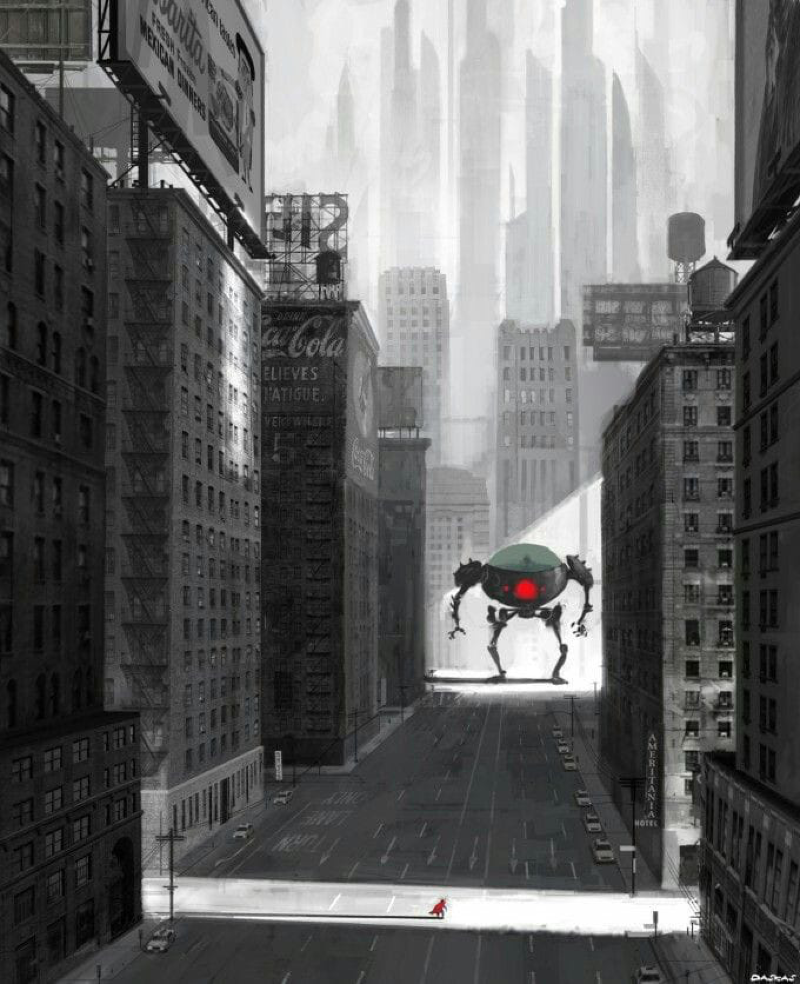
Superman is a good movie.
It’s quick, it's breezy, it's fun and funny, and it's got some really great comic book action. It's a good time. It's not deep, of course, but much like Superman himself, while it's pretty straight forward, it is also clear-eyed in its message... right is right, wrong is wrong, and we all know the difference when we see it.
The main thing that this movie gets right is that Superman is a firefighter, not a cop, and that nuance makes all the difference. That's the thing the Snyder Cultists hate about the most about the character, and it's the thing that the SnyderCult movie version not only didn’t do, but was incapable of even understanding.
There are some people out there who say that Superman is too powerful, and because of that, it's too hard to make a good story with him. But the only reason they say this is because they don't understand who the character is, or that a good Superman story is actually pretty easy, if you focus on the right elements.
One...

Self-sacrifice. Selflessness. Superman puts others first. More so, he thinks about the reprecussions of his actions. He's constantly aware that he needs to be careful, because a careless act on his part could hurt others, just as he is constantly aware that he's the one who has to stand in the way in order to protect others, that he's the one who has to take the brunt of it. And not for the accolades either, or for the recognition, but because it's his responsibility, He's stronger. He's more powerful. With the gifts that he has, with the privilege that he was born with, this is his duty, and he does it because it's the right thing to do. And while he is well aware that he can't be everywhere at once, that he can't save everyone, that doesn't mean that he's not going to try.
That's the "super" in Superman's name, and it is a vital part of the character.
Two...
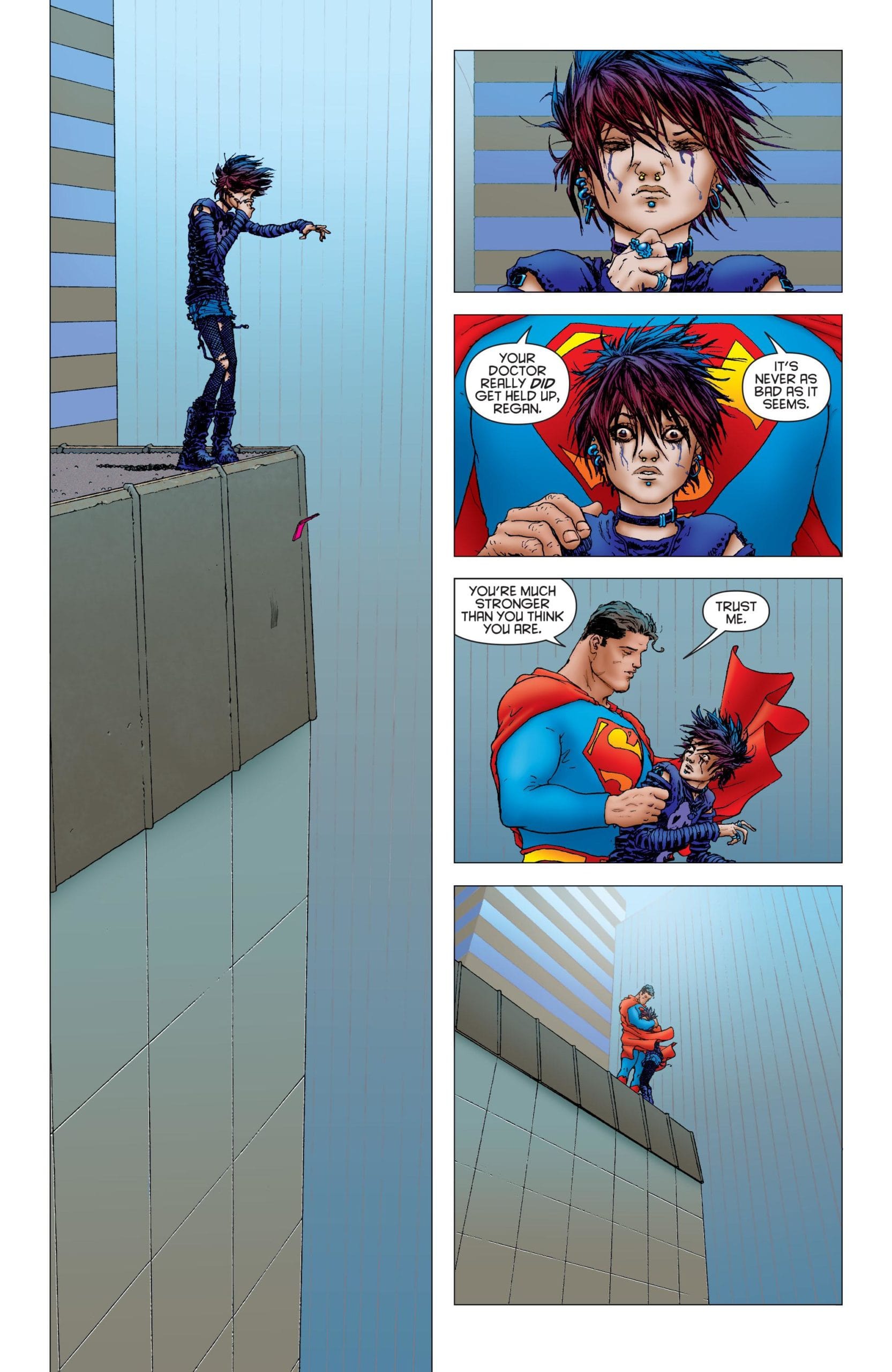
Superman cares. Not just about the world, but the people in it. He believes in humanity. He believes that they can better. He believes that even though they're still on that journey, and that even though they will stumble at times, all of them still have value. Everyone and everything matters, so any moment you take to show that is important. This is best exemplified in the film, when, as the world is falling apart, Superman is busy saving everyone he can, and that includes saving a lone squirrel from being squished.
Apparently this was a hotly debated moment, as test audiences (AKA Burbank trash randomly scraped up off a Valley sidewalk one day) groused about it, and the filmmakers and producers and the studio went back and forth on whether or not it should be cut out, but it was left in because it's a key moment to both the film and to the character of Superman. It's a moment that is about being kind and good and loving, one that show how compassion is the answer to everything. That’s the "heart" of the whole thing.
This is the "man" in Superman's name, and it is just as vital as the "super."
In fact, in many ways, the "man" is more important than the "super." That Kansas farmboy is the core of the Earthbound God, without that aspect, all you get is a character like the Homelander, or Omni Man. This film understands that.
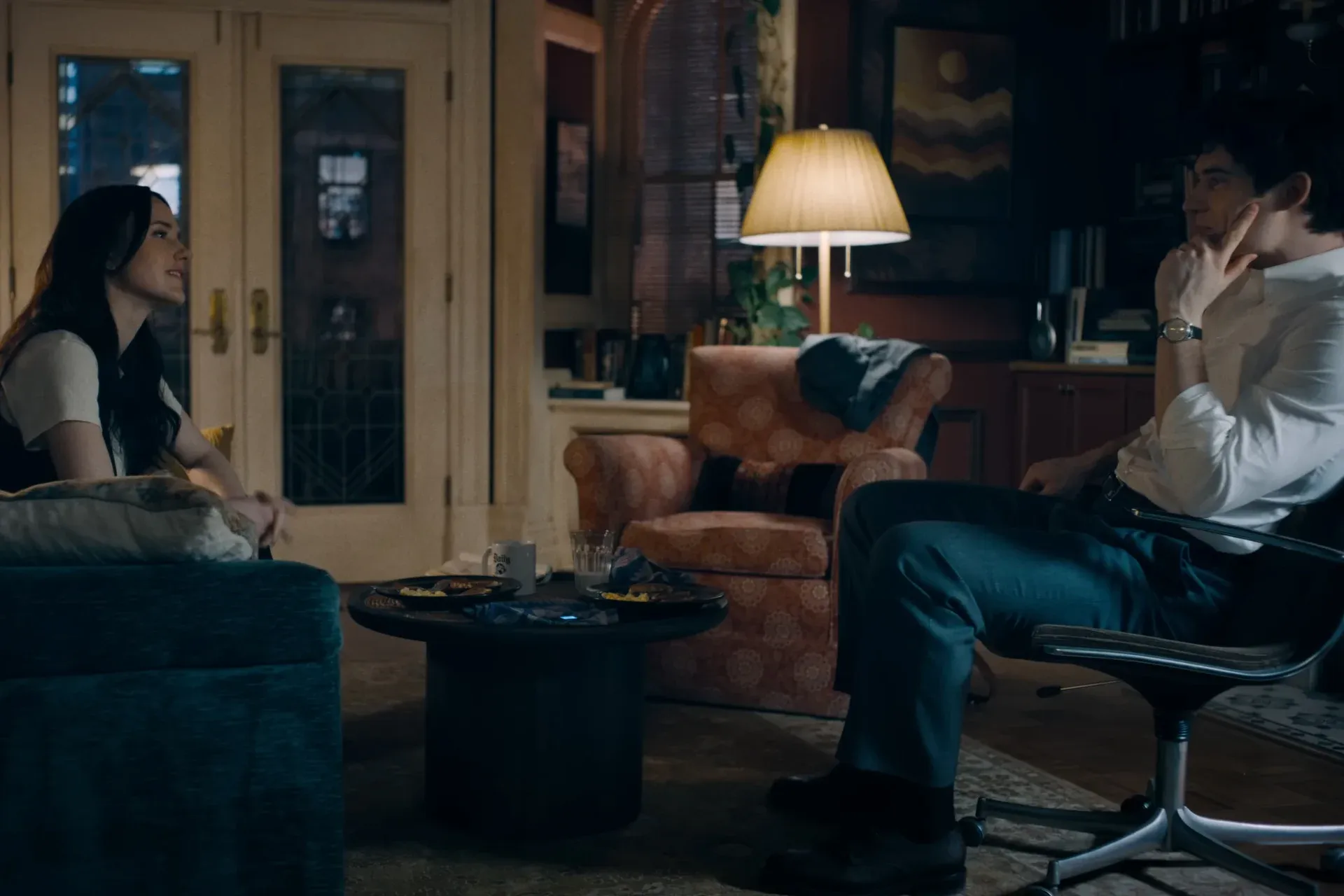
One of the best moments in the movie is early on. It's when Lois comes home to her apartment and finds Clark there cooking her “breakfast for dinner." It's meant to be a surprise to celebrate their three-month anniversary, as Clark tells her that it's her favorite. But there's some tension at this point in their relationship. Three months is kind of the first make-or-break landmark. They're still getting to know each other in a more intimate way. Plus, the question of will this thing continue or should it end now, is also rubbing raw against everything that is happening in their world at that moment. On top of that, the fact that Clark is Superman, and Clark Kent, as a Daily Planet journalist, keeps giving himself exclusive puff-piece chats with Superman, which raises his profile at work, irks Lois, who is a better reporter than him, and now has to work that much harder in order to get as the same level of recognition that Clark does, when he is just handing himself opportunities. This bubbles to surface as Lois replies that no, "breakfast for dinner" is your favorite.
Sensing the tension, and wanting to smooth things over with he, Clark agrees to give Lois an on-the-record interview with Superman. He clearly has no idea what it means to be grilled by a real journalist, which is exactly what Lois does. The result is a very sharply written, quick, and well-acted exchange that is perfectly delivered as a comedy, but with some serious undertones, that then becomes more and more serious, and more and more overtly, as Lois pushes Clark with some fair but tough questions about the ethics of his recent decisions to intercede in the affairs of other countries. It's a line of questioning that is frustrating for Clark, because to him, it's simple. "People were going to die." It's a great scene that shows how complex these kinds of questions can seem to be, while also illustrating how simple they are.
And that's something I really liked about this film all around.
I really liked how the real world parallels are obvious in this film, and they are stated plainly, but all as part of the story. Whether it's the masked agents locking Superman up in an extra-jurisdictional off-site prison without legal counsel, right next to people who were jailed for where they're from, or for something they said in public, or it's Superman not wanting to kill the Kaiju, or saving the squirrel, the world right outside our window is clearly on display.
There's right. There's wrong. And we all know it when we see it.

Another thing I liked is how Superman treats its characters, and the details of its world. I love how Krypto is an endearing, loving, and loveable dog, but ultimately, he's also kind of a bad dog, but that's mostly because he's not trained. I loved that this is a world that has been aware of metahumans for a long time, as evidenced by the orderly manner in which the citizens of Metropolis evacuate during the climax, because this, like with the Godzilla bunkers in the show Monarch, shows how the people of this world have been in this kind of situation before, and they know that the best thing to do when Gods and Monsters tussle is to just get out of the way. I also really love the hints of metahuman history sprinkled throughout the film, like the half-glimpsed mural on the wall of the Justice Gang's familiar headquarters. I loved how the various characters of the Daily Planet and also Ma and Pa Kent were all so clearly drawn, and how their actions told us who they were.
And I really loved how Lex was clearly a Bezos/Musk tech billionaire douchebag, an irresponsible and selfish sociopath whose reputation as a genius was only half-deserved at best, because I love nothing more than when a movie shows us an accurate reflection of who the real bad guys truly are in today's society.
But most of all, I loved the Justice Gang. Great choices.

All that said, I did have a couple of small complaints...
Like, I really didn't understand Jimmy's reaction to Ms. Teschmacher. Jimmy is supposedly a ladies man in this movie, and a glimpse of his phone seems to show lots of women's numbers, and one of them was listed as "Mutant Toes" and this turns out to be Eve Teschmacher. Eve is super into Jimmy, even though Jimmy is not into her at all. At all. Despite him being a short redheaded man, and her being beautiful, and the fact that they have previously dated, Jimmy clearly thinks she is awful. And sure, she's obviously clingy, and maybe he's just not into her, which is fine, but she did singlehandedly bring down Lex Luthor through a surprisingly clever plan, and without her help, there would've been no story to publish, and no clearing of Superman's name, and all she asked in return was a dinner date... So why is Jimmy such a huge dick to her about it? He acts like it's so awful interacting with her, and I can’t figure out why. Throughout the film, while she is ditzy, sure, and like I said, she’s clingy, but for the most part, she seems to be nice and sweet. I honestly don't get it. Okay, yes, sure, it’s fair to say that she clearly wanted to be boyfriend/girlfriend again, and it's cool if Jimmy isn't into that, but he could've still been nice to her and said something like: "Of course I'll take you to dinner as a thank you, but I’m not looking to date right now, so we'll see where things go after that." I mean, in my opinion, he clearly owes her at least that much.
Plus, at one point, Eve mentions that Jimmy told her while they were briefly dating, that her toes look like someone "spilled shrimp cocktail on the ground," which is not only a generally shitty thing to say, it's an imagine I can't reconcile at all. And the film never clears it up. Does this mean her toes are curled and overlap as a result of her wearing fashionable high heels that don't quite fit, that Eve has sacrificed straight toes at the altar of cute shoes, because sometimes one must suffer for fashion, and now her toes are permanently weird shaped? Or... does Eve Teschmacher actually have honest-to-God mutant toes in some way that really do look like someone “spilled shrimp cocktail on the ground," something that is not necessarily outside the realm of possibility in a comic book world?
Basically, was Jimmy being a jerk or a bigot?
He was definitely a jerk to her either way, because again… what was so bad about Ms. Teschmacher? Sure, she has bad taste in men, and like I said, it's totally fair if Jimmy just wasn’t that into her, that’s fine, but the way Jimmy acted toward her, it makes no sense to me. I think we definitely needed to see Ms. Teschmacher’s toes, just to know what was going on their either way, but all that aside, it bothered me that Jimmy wasn't nicer to her, especially in the end. Maybe it was supposed to be that Jimmy's fear of commitment was the actual problem, but if that was the case, then that needed to be presented in the film more clearly.
The whole Jimmy/Teschmacher subplot was so inexplicably odd, that it turned Jimmy into a bit of an enigma for me, forcing me to consider potential reasons for why Jimmy might not be into Eve, when the only reason that we were given was of the "she smelled of soup" variety. And this led me to wonder what was going on with his whole character. A big part of the meta-narrative of the film that we saw in the press, and in people's reactions, was that this was all part of a funny subplot of how Jimmy was a surprisingly successful ladies man, and that made me wonder...
Is he though?
At no point in this film do we actually see Jimmy express any interest in any women. And that’s fine. But then, when you couple that fact with the fact that the thing we do see him express when he interacts with women, who could possibly be potential partners, is disinterest. He was not only clearly uncomfortable with Eve Teschmacher, but he was also uncomfortable with and not interested in both the sex workers he encountered in a Metropolis back alley, but also with the attention of the two women in the Daily Planet's office who were smiling and giggling at him. And this made me wonder, was Jimmy intended to be closeted, but WB/DC made Gunn cut it out due to fear of a bigot backlash?
What did it all mean?
Additionally, while I really liked how the bad guys were shown to be brutes, or dupes, or tech bro loser incel billionaires like Musk and Bezos and Zuckerberg, or sloppy gross old clowns like Trump, all bolstered by a gibbering news media eager to parrot every lie and piece of bullshit propaganda they were given, to an audience of slobbering idiots and stooges eager for a reason to give vent to their xenophobic hatred and bigotry… being someone who lives in this modern day world as I do, I honestly found the idea that a single well-written and honest piece of journalism from ethical, professional, and well-trusted journalists would be enough to turn everything around and save the day, was simply too much of an outrageous and naive fantasy for me to swallow, even in a movie centered a super powerful being from outer space who wears tights and a cape.
I just don't believe it.
I mean, look how the overwhelming majority of white America and their favorite “news” source reacted to the film…
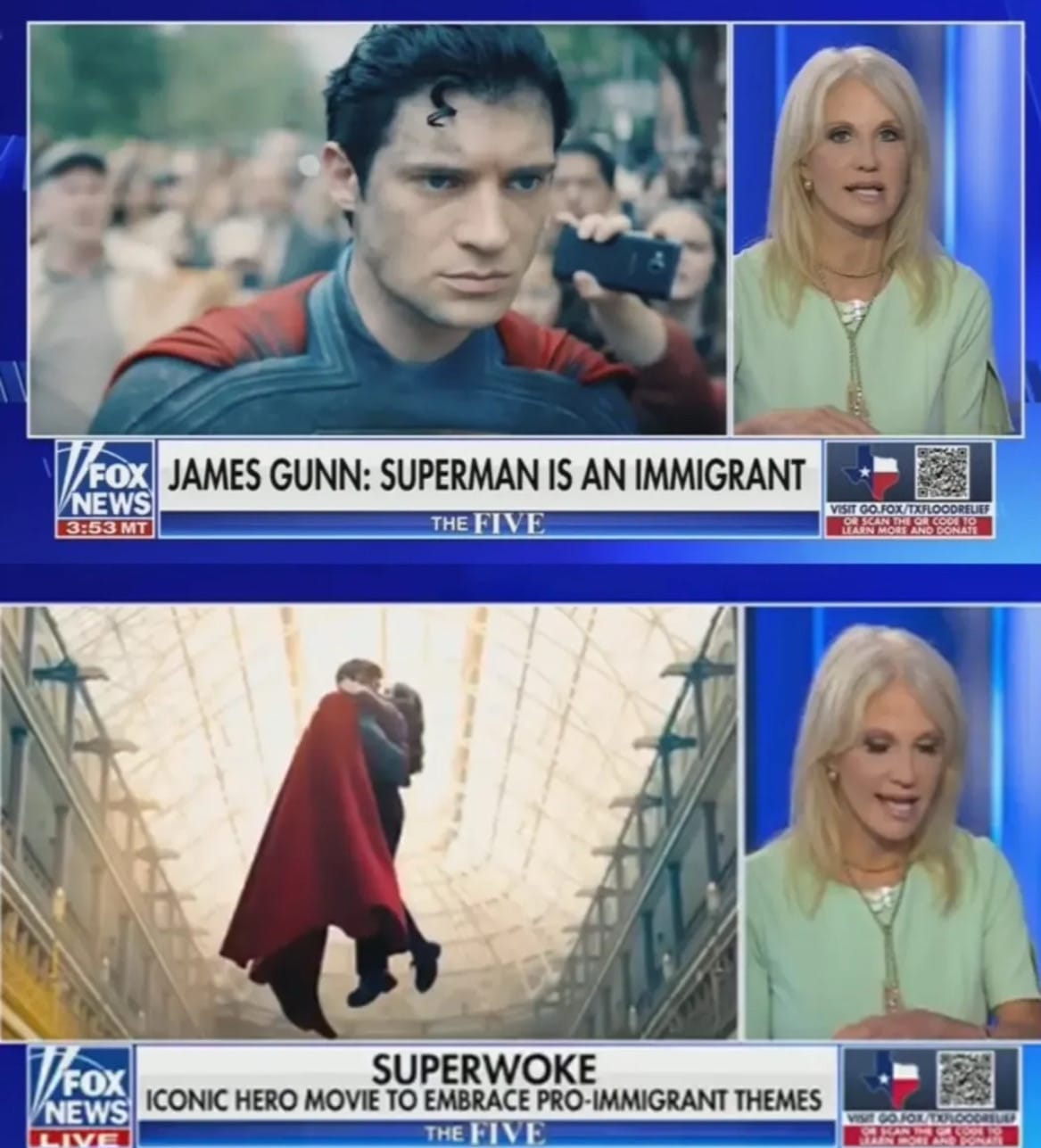
In the days leading up to the release of the film, we were "treated" to yet another example of how bigots only ever use terms like “woke” and “immigrant” now as a pejorative stand-in for the slurs they're really saying. And why were all these ugly bigots so upset?
Simply because the character was stated to be exactly what it has been for the entire 87 years of its existence.
Nothing was changed about Superman in this movie. Nothing was added to the story of the character to fundamentally change who he’s always been. Superman's story has always been an idealized version of the American dream, the story of a stranger finding a new home on a far away shore. The only thing that has changed is the overwhelming majority of white America, across all demographics, the ones who voted for Trump three times now, and also the ones who support, enable, and make excuses for those bigots, have taken their masks completely off to show us their true face once again. An undeniable reality that only shows how much of a fantasy the whole idea of believing in the goodness of humanity truly is.
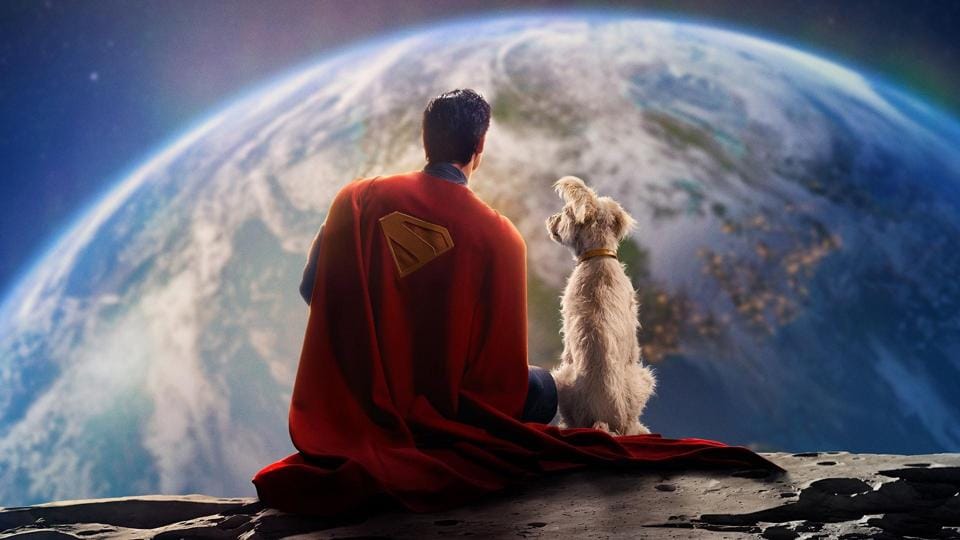
Still, hope springs eternal. Maybe Trump and RFK jr. will convince them all that cyanide is good for them. Fingers crossed.
Anyway, in the end, Superman isn't just a fun time. It’s a nice light of hope and kindness in a dark world, while also presenting a simple truth, if you're willing to listen... There's right. And there's wrong.
It's just that simple.
